We’re excited to share that the latest official minor release of Camunda is now live and available for download. For our SaaS customers who are up to date, you may have already noticed some of these features as we make them available for you automatically.
Below you’ll find a quick summary of everything new in Camunda with the Camunda 8.5 release.
Table of contents
- Self-Managed
- Identity Enhancements
- Web Modeler
- Addition of documentation section to Design mode
- Public API – Beta removal
- Resizable properties panel
- A11y – WCAG 2.1 A compliance
- Web Modeler-based cluster creation journey
- Process template import via link
- Enable login for users without email addresses on Web Modeler Self-Managed
- Simplify BPMN Modeling on the Canvas
- Public API support for renaming and restoring milestones
- Bulk download of files and folders
- Enable stakeholders to validate business logic without risking unwanted changes
- Restricted Production Deployments (SaaS only)
- Play
- Desktop Modeler
- Connectors
- Operate
- Zeebe
- Optimize
- Tasklist User Interface (UI)
- Tasklist API
- Forms
- Camunda 7
- Thank you
Self-Managed
Camunda Console Self-Managed
We are excited to announce the release of a new Camunda component: Camunda Console Self-Managed. This new Console has been developed to enhance the management and monitoring of Camunda installations within an enterprise environment.
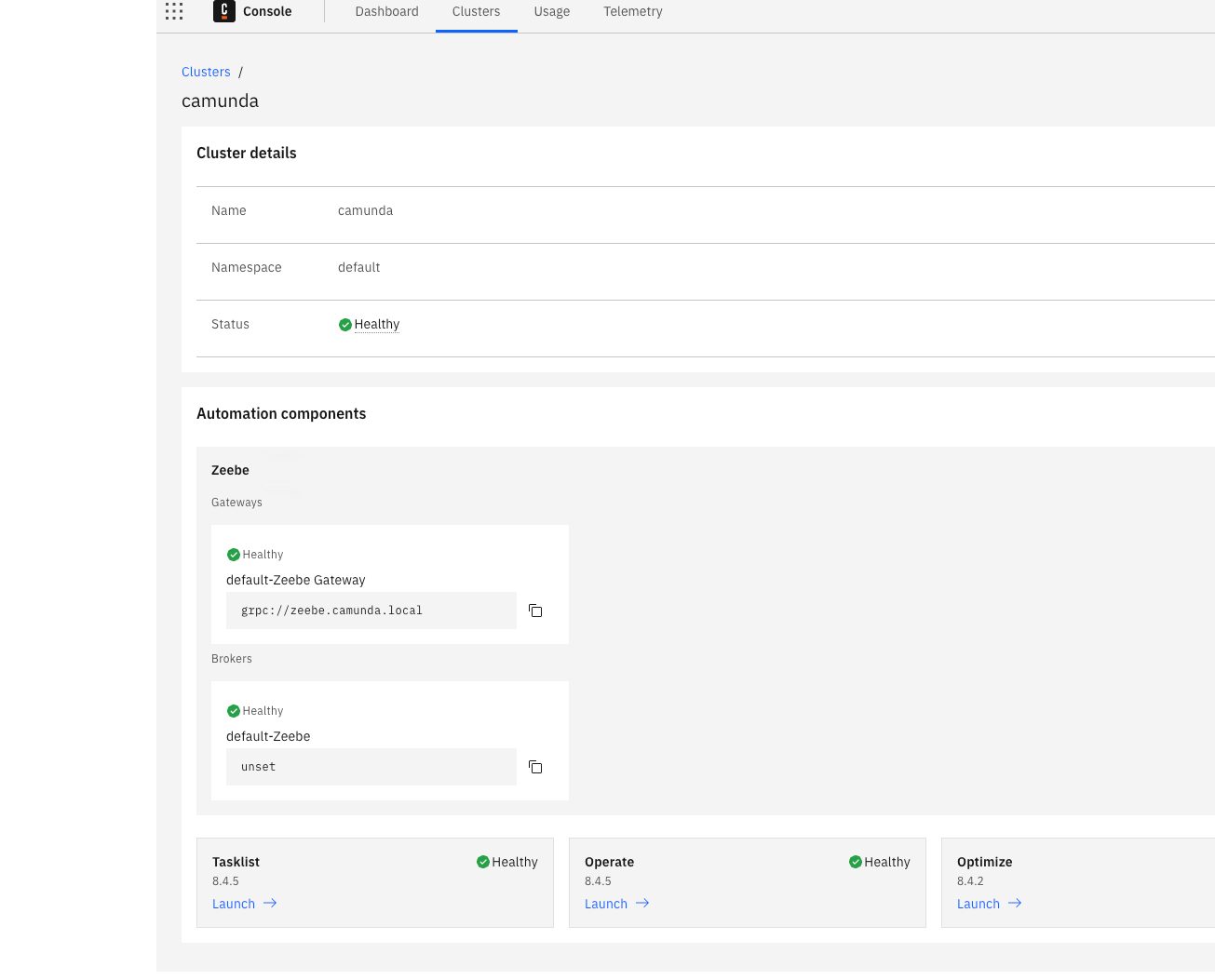
It facilitates a clear and concise overview of the Camunda platform when deployed on Kubernetes, making operational tasks more streamlined and efficient.
To get started and to learn more about the Camunda Console Self-Managed, visit our documentation.
Simplified Installation and Configuration
External Elasticsearch support
With the 8.5 release, integrating external Elasticsearch with Camunda has been significantly simplified. We’ve optimized the configuration process to facilitate the use of external Elasticsearch as an alternative to the embedded option. Additionally, our Helm chart has been updated to accommodate use cases when external Elasticsearch is used, such as on Elastic Cloud, self-managed on-premises installations, etc.
Amazon OpenSearch support
Our latest Helm chart also supports Amazon OpenSearch with few configurations in the Helm chart. It’s as easy as using external Elasticsearch.
Enhanced applications configurability
The Camunda Helm chart is highly customizable. With this minor release, we provide a more flexible way to configure any Camunda platform application allowing users to pass application configuration directly in the Helm chart. With this change, our Helm chart is less dependent on the application versions, and there is no need to wait for the Helm chart to support specific application configurations.
Improved Documentation Structure
We have reviewed our Self-Managed documentation and restructured the installation, upgrade, and deployment sections for a better and simpler user experience. Finding all the needed information for Helm chart setup on Cloud platforms or Kubernetes and OpenShift clusters is much easier now with the improved structure.
Want to know more? Check out Camunda’s Self-Managed and Helm chart documentation.
Enhanced Availability and Operations
Official Support for Zeebe Rolling Updates
Zeebe now fully supports Rolling Updates which means you can update a Zeebe cluster broker by broker to the latest patch or minor version without any downtime.
You will find documentation on how to execute the rolling update and HELM charts simplify operations of updates.
Azure Hot Backups Support
Zeebe Hot Backups can now be stored in Azure Cloud Storage. This means you can now run a Hot Backup with your Azure Cloud Storage for Zeebe, Operate, Tasklist, and Optimize since Elasticsearch also supports Azure Cloud Storage.
Support and Guides for Multi-region (2-Regions) Setup
You can now run Zeebe, Operate, and Tasklist across data centers in two (2) geographical regions. We have also added new documentation for Dual-Region setup: You will find installation and failover guides to help you recover quickly and safely from whole region failures.
Note: At this time, there are no dedicated guides on how to set up Optimize, Identity, and Connectors across regions. Support for them will be added in the next releases.
Identity Enhancements
Role Management with your Open ID Connect (OIDC) Identity Provider
With this release, you can use Role-Based Access Control (RBAC) with your own OIDC Identity Provider (i.e. Entra ID) and Camunda 8 web applications without relying on Keycloak. This is a powerful enhancement as it removes the requirement to have Keycloak as part of your Camunda 8 Self-Managed installation.
Simply create roles within Identity, and assign component-specific permissions (e.g. view-only Operate) to the roles. Then create mapping rules to automatically assign users to specific roles based on authentication token claim values.
Multi-Tenancy Support with your Open ID Connect (OIDC) Identity Provider
On top of the Role Management, you can now use Camunda 8 and multi-tenancy with your own OIDC Identity Provider (i.e. Entra ID) without relying on Keycloak. Simply create tenants and define mapping rules within Identity.
Mapping rules allow you to automatically assign users or client credentials to specific tenants or roles based on authentication token claims.
Simplified Integration of Keycloak with AWS IRSA
We have introduced a new Docker image (camunda/keycloak) containing the AWS JDBC Wrapper. You can use this image as a drop-in replacement for bitnami/keycloak, when installing Keycloak with the Camunda Helm Chart.
This image simplifies Keycloak installation for AWS users wanting to use a more secure IRSA (IAM Roles for Service Accounts) passwordless authentication between Keycloak and Postgres by eliminating the need for users to build their own Keycloak image. You can find more details about this project on GitHub and in the IAM roles documentation.
Web Modeler
Check out these new features and capabilities within our Web Modeler with the 8.5 minor release of Camunda.
Addition of documentation section to Design mode
Sometimes when designing processes, users might be unaware of the documentation field or they may even change their implementation settings while in the wrong mode in Web Modeler.
With this release, Camunda has enhanced the accessibility and usability of the ‘Documentation’ feature in the Web Modeler by adding it to the Design mode. This change ensures that the documentation information is readily available and visible within the properties panel, streamlining the design process.
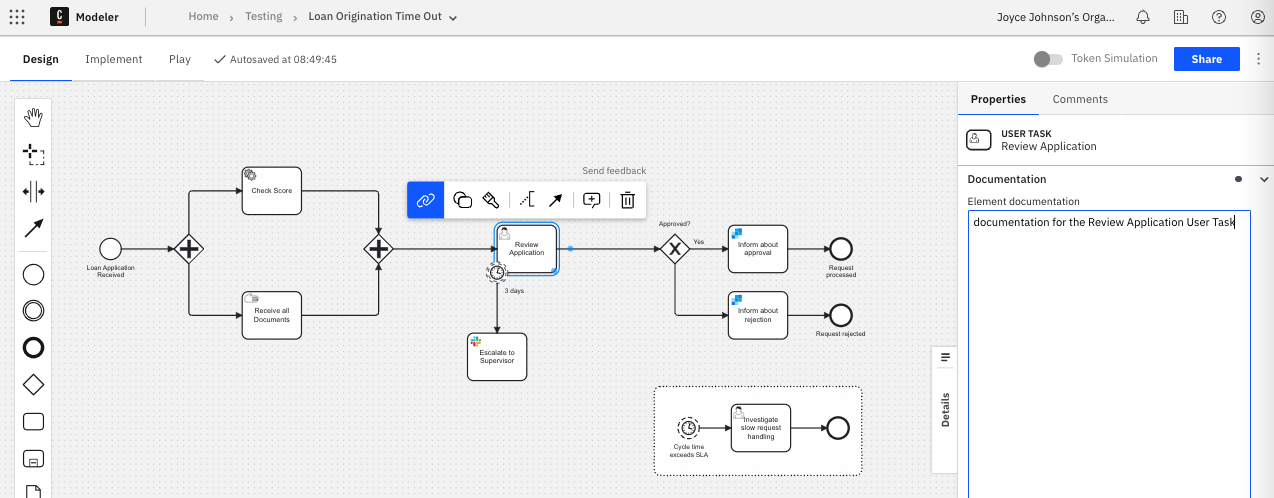
Public API – Beta removal
We have adopted the latest Web Modeler API changes and as announced with the 8.3 release, have removed the Beta API from this release.
Resizable properties panel
Now while working in Web Modeler, you can resize the properties panel. You can see how to expand and reduce the properties panel in the short clip below.
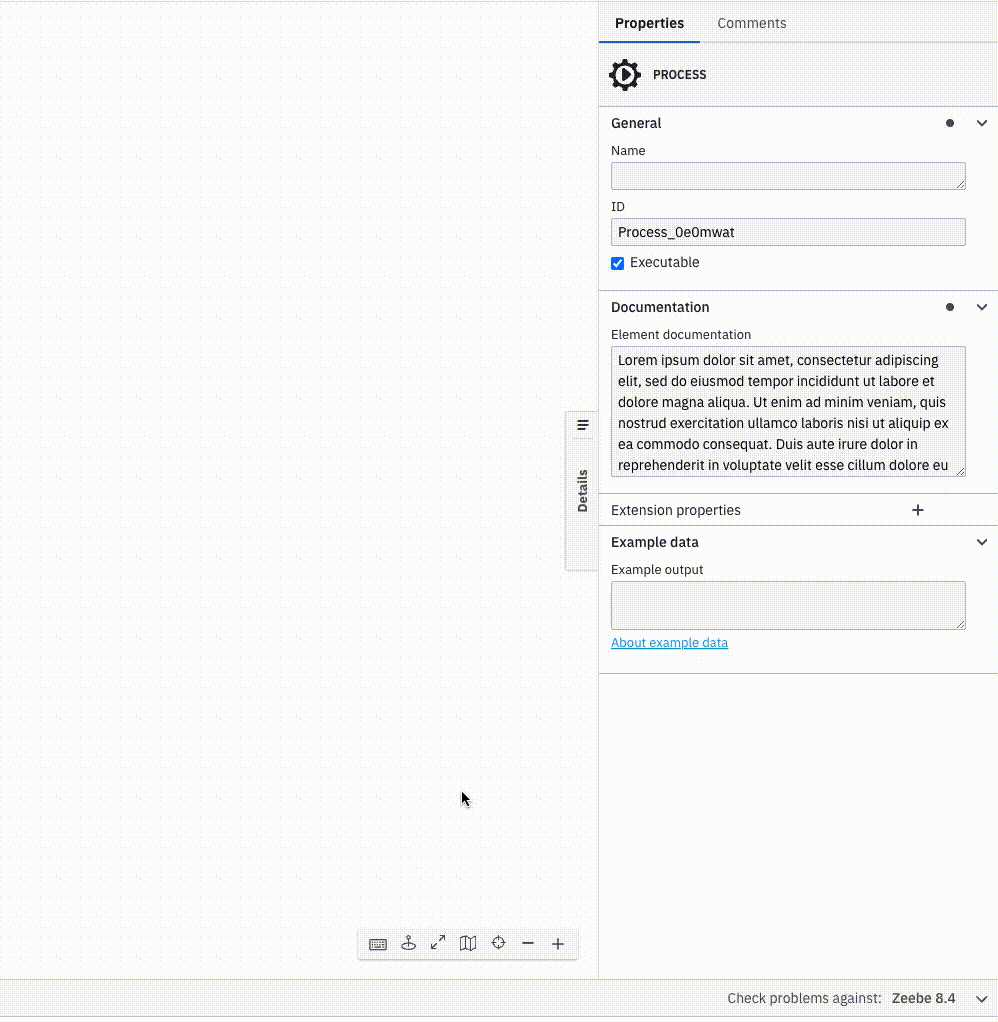
A11y – WCAG 2.1 A compliance
Camunda continues to provide a product that is accessibility compliant to its customers, allowing users who have limited motor abilities to use the product. Camunda uses the WCAG 2.1 A accessibility standard as our benchmark.
Web Modeler-based cluster creation journey
Although Camunda Web Modeler is one of the primary applications for Camunda, a critical step was missing after creating a diagram for deployment—cluster creation and Connector Secrets still take place in Console.
With this release, Camunda provides additional features to assist users in making clusters and verifying Connector Secrets are defined before your diagram is live. Now you can:
- Navigate directly to the cluster from Web Modeler to make updates
- See checks done by Modeler around adding secrets to your diagram
- Manage clusters through a simple link on the dialog provided
These usability improvements provide a better-designed empty state that explains the need to create a cluster (shown below).
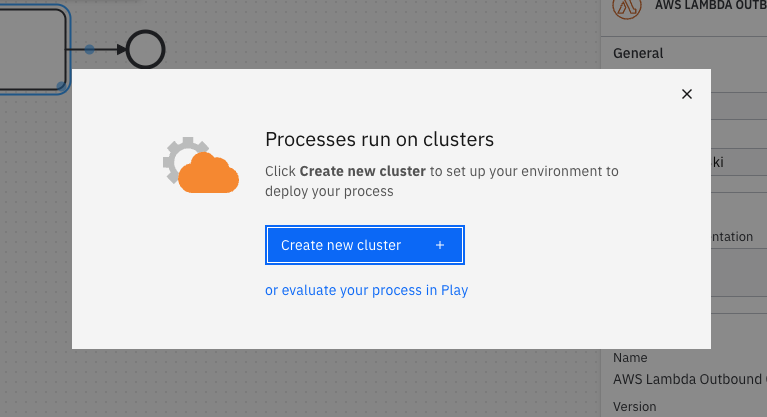
Console opens in a new tab in your browser so that you can configure API credentials and secrets and easily return to Modeler.
You are notified if there are Connector Secrets used in the diagram that are not currently configured in Console along with a warning message to help manage these instances. A simple click on the link to manage the cluster is provided.
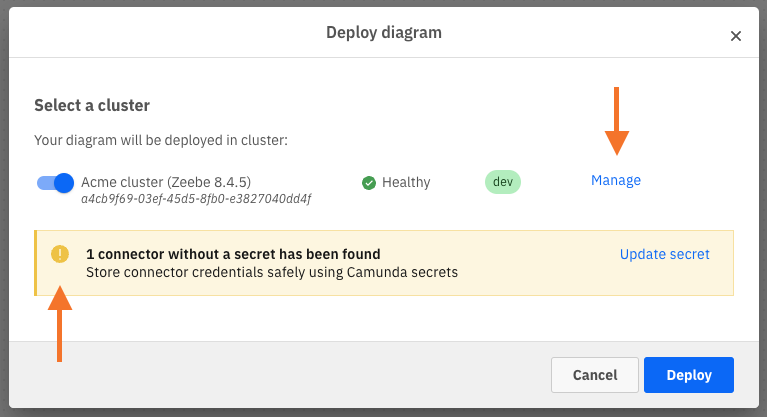
Process template import via link
With this minor release, we have simplified the incorporation of process templates in Web Modeler. This was done with the following in mind:
- Simplicity: We have facilitated a direct link integration for downloading process templates into the Web Modeler, eliminating manual steps and simplifying the user experience.
- Connectivity: We have established a seamless bridge between the public marketplace and the web modeler, allowing for the direct incorporation of marketplace discoveries into user workflows.
- Productivity: We are fostering a more productive environment by reducing the time from template discovery, in the marketplace, to deployment in the web modeler.
Enable login for users without email addresses on Web Modeler Self-Managed
With this release, you can set up Web Modeler easily with any LDAP user configuration. This addresses those customers that maintain their own development LDAP directories, such as Active Directory, with a subset of users in their corporate LDAPs as well as other configurations of LDAP.
With the 8.5 release, users of Web Modeler Self-Managed, email addresses are not required to access Web Modeler.
Simplify BPMN Modeling on the Canvas
With Camunda’s new simplified modeling canvas, we have enhanced the user experience providing familiar UX patterns, guiding common actions, and quick access to modeling actions. With this simplified modeling experience, the needs of both new and experienced users are addressed. Our new approach to accessing modeling actions, such as appending elements, connecting them, and modifying their properties through a new context pad increases efficiency while modeling your processes.

See Start Modeling Faster with the new Simplified Modeling Canvas for more information about this feature.
Public API support for renaming and restoring milestones
With this minor release, we have provided additional capabilities in our Public API to support milestone access and modification. Developers can now both rename and restore milestones using our new REST API endpoints:
- Renaming a milestone can be accomplished using the
PATCH /api/v1/milestones/{milestoneId}<br>WheremilestoneIdis the milestone you want to rename.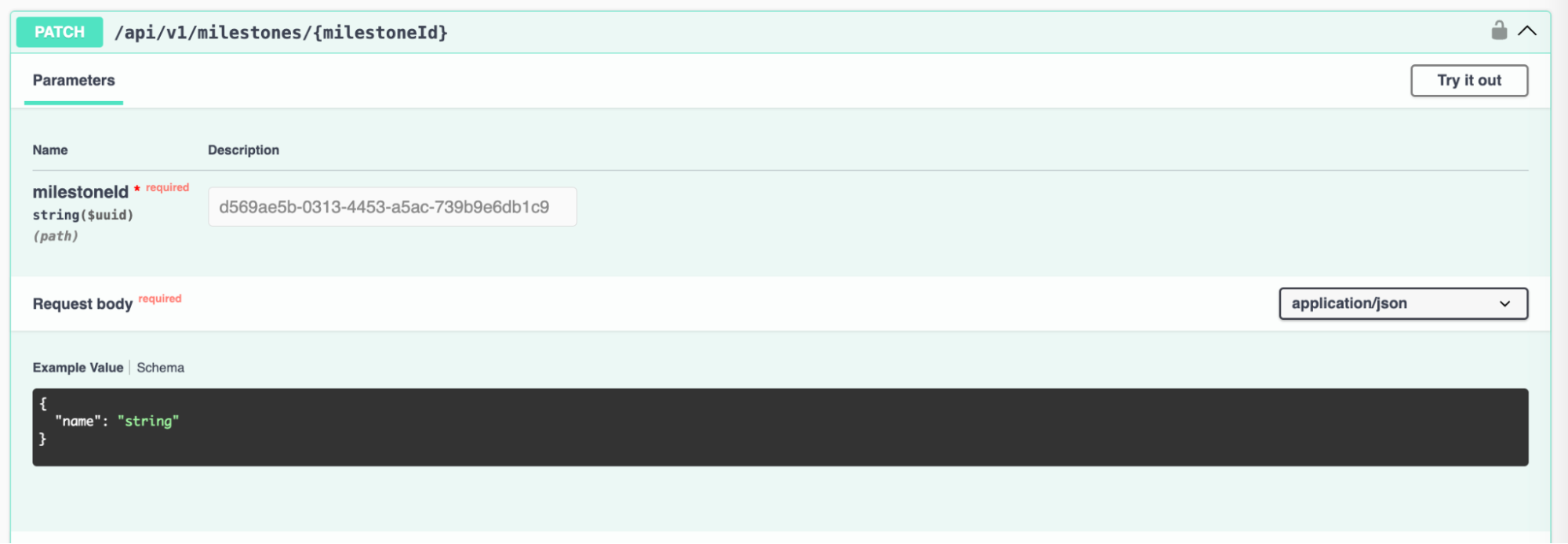
- Restoring a milestone can be accomplished using the
POST /api/v1/milestones/{milestoneId}/restore
WheremilestoneIdis the milestone you want to restore.
Bulk download of files and folders
With previous versions of Camunda, only single files could be downloaded from a project. With the addition of check boxes next to each item, you can select all items—files and folders—in a project or just a few and download them in a zipped format.
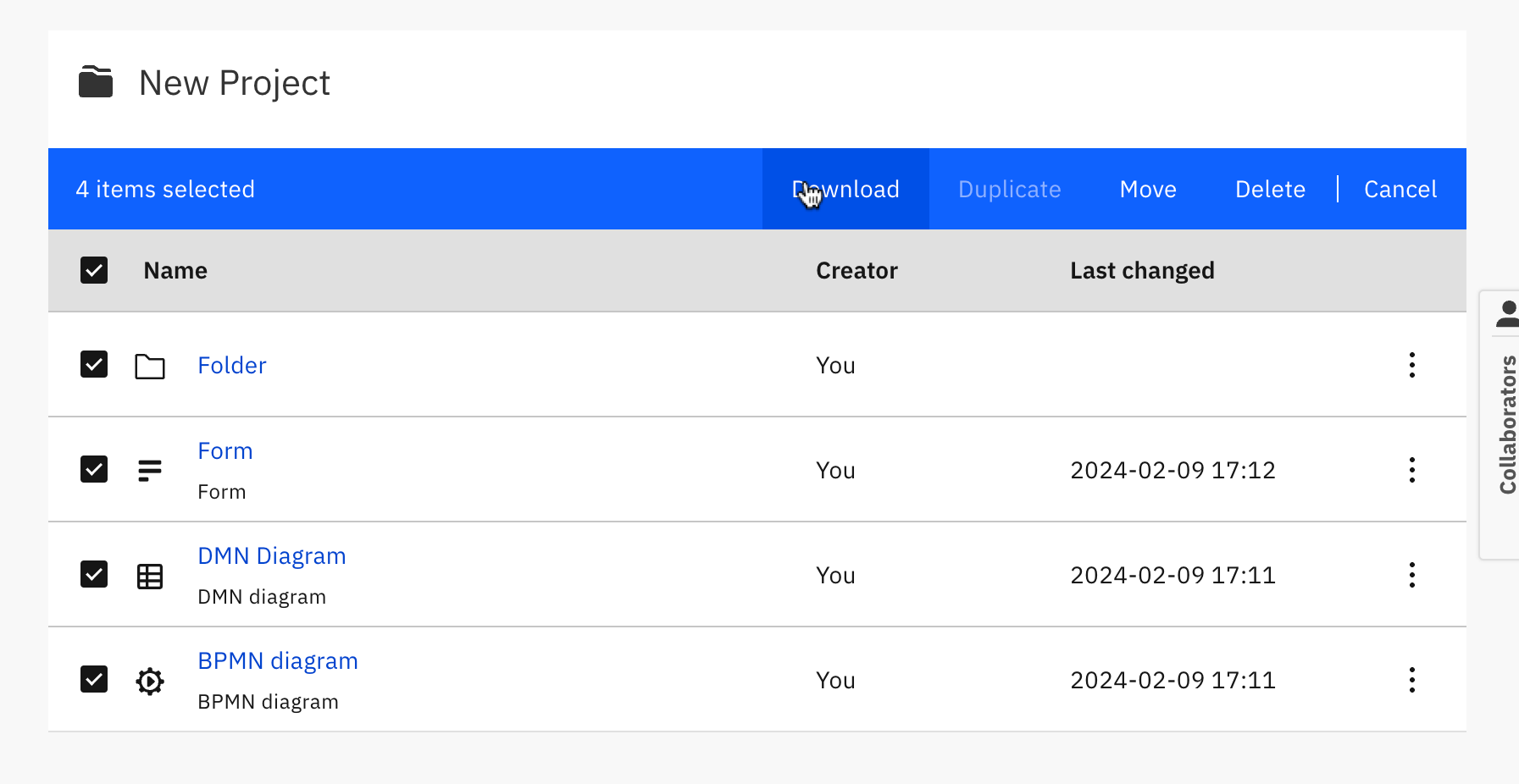
This quickly transfers files to other tools such as Desktop Modeler, version control systems, and more directly from the User Interface (UI).
Enable stakeholders to validate business logic without risking unwanted changes
Previously, users with read-only permission for a project—viewer and commenter roles—did not have the proper security credentials to see the technical implementation details for the project. In this release, commenters can now access the Properties and the Problems panels in read-only mode. They can see the properties, but cannot make any changes.
This feature has only been added for BPMN and DMN diagrams. In a future iteration, this will also be available for Camunda Forms.
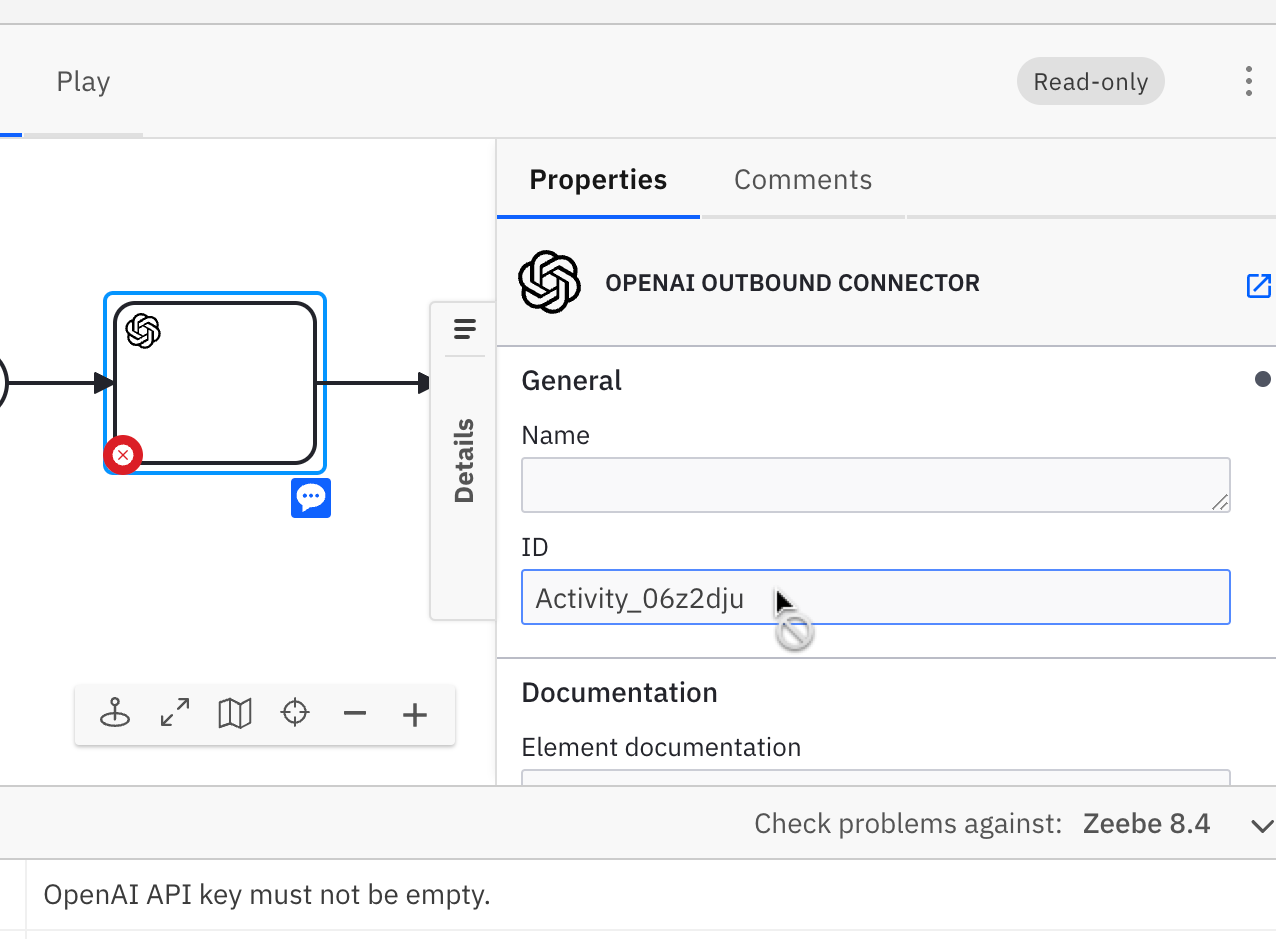
Note: Commenters still cannot deploy or start a process instance; however, they can access all modes as read-only (Design/Implement/Play).
Restricted Production Deployments (SaaS only)
There may be a risk of inappropriate deployments to production environments that can break a process, for example, in rapid prototyping situations. Now Camunda only allows organization admins or owners to deploy to production clusters. All other users can only deploy to a development, test, or staging cluster.
This feature aims to mitigate this risk by restricting the production deployments while still allowing deployments to development, test, or stage clusters.
We have also extended the super-user access to all SaaS admins to include the ability to publish Connectors at the organization level. With this improvement, the organization owner isn’t the bottleneck anymore for administering all the projects in your Web Modeler deployment.
Play
Rewind
With the new Rewind feature, users can play different use cases of your process faster by jumping back to take a different path or trying a different variable combination.
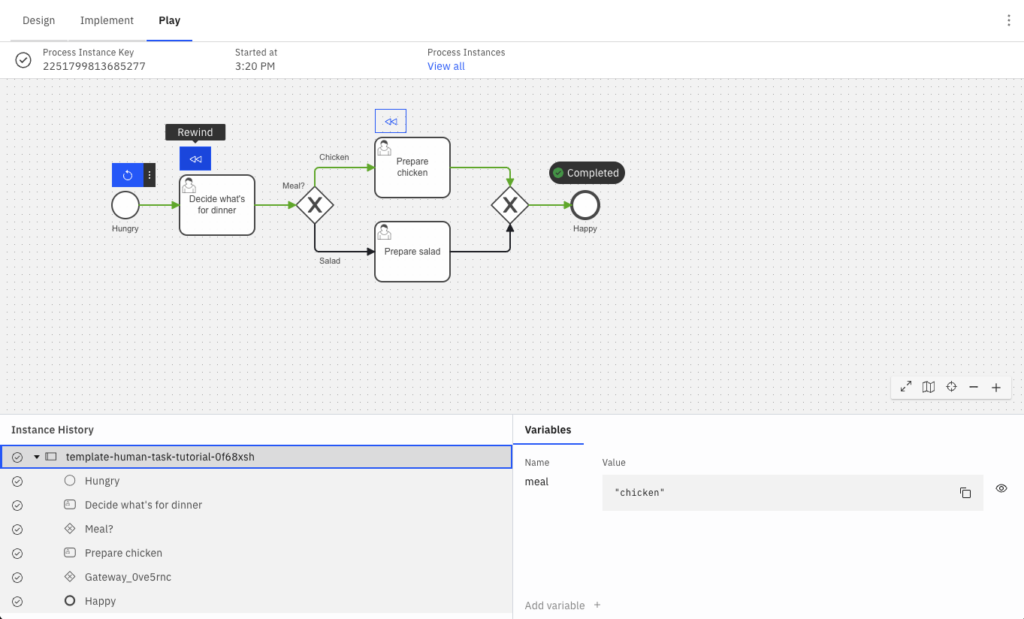
Discoverable and pretty variables
Ensure data flow in your process is expected by finding and reading your variables easily. Click on an element to see its local variables and view a pretty version in a spacious modal. This variable viewer also works when entering variables for a consistent look and feel.
Explanatory notifications
As a new user, you can learn how Play works as you use it, and the differences between Play execution and Zeebe execution. Get visual feedback as your process instance goes through its journey, encounters incidents, and has updated variables.
Easier error triggering
Easier error triggering: Efficiently play process with errors by select from available errors rather than referring back to the BPMN diagram
Prefill form example data
Share your process so your colleagues can play it accurately and easily. Save variables and human task form fills to the “Example data” field, then Play will display them by default when you complete tasks with variables or a form.
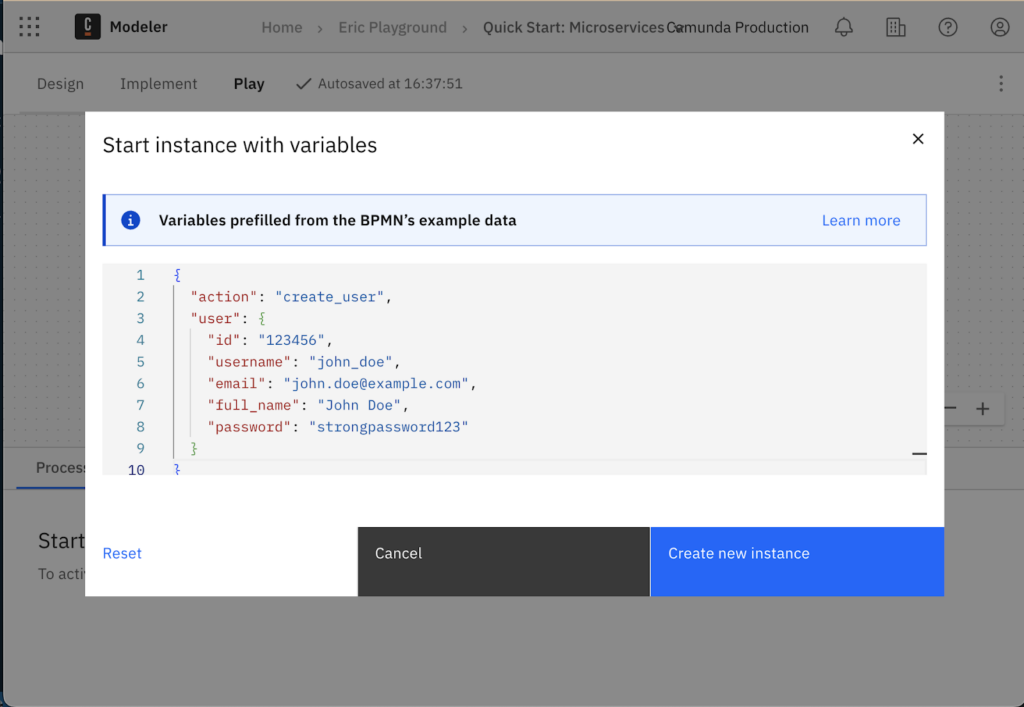
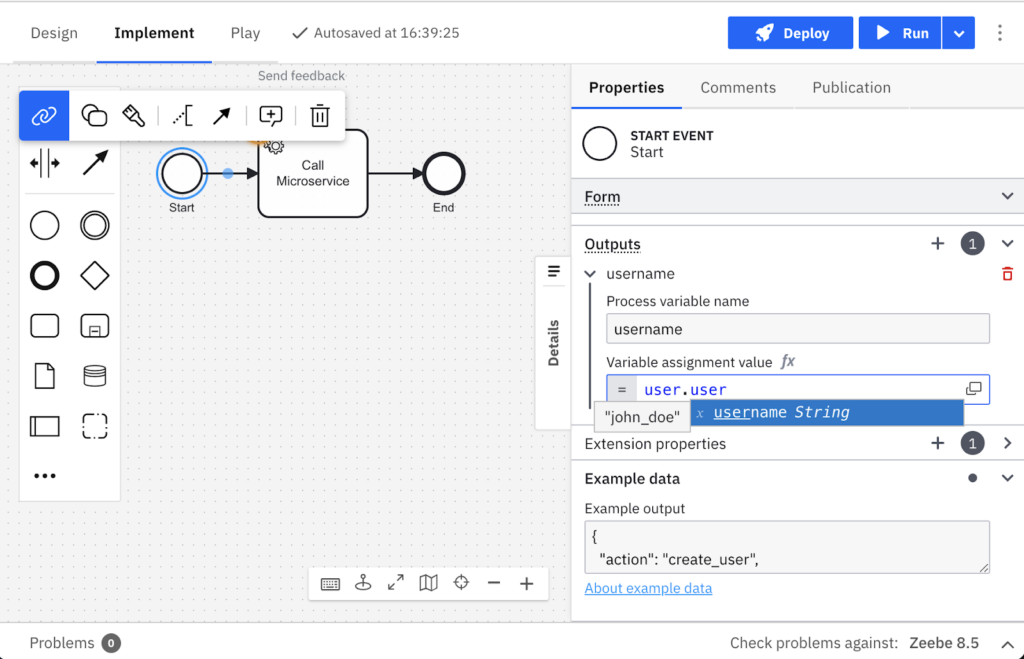
Desktop Modeler
Support for compensation events
With this release, we introduce support for compensation events in Camunda 8. For example, you can now model compensation throw and boundary events and set compensation activities.
Improved user task tooltips
With our 8.5 release, we’ve improved the tooltips to provide better guidance on Zeebe user task usage.
With the introduction of Zeebe user tasks, Modeler users can decide to switch to User Tasks managed by Zeebe. With this release, we have added additional information—via tooltips—so that users can more easily select the correct implementation type for their task applications.
Expression field in Forms
Previously, users were unable to reuse the results of FEEL expressions in Forms. With the new expression field, you can precompute data at runtime using FEEL.
Form developers can now add expression components to forms to calculate and store values and reuse them in other components, allowing them to break down complex expressions in multiple steps, and to return calculated values as form output.
As always, this release incorporates bug fixes and additional minor improvements. Check out the full release notes for this month’s Desktop Modeler 5.22.0 release right here.
Connectors
Secrets in Hybrid mode
Self-hosted connector runtimes that run in a Hybrid mode (connected to Zeebe in a SaaS cluster) can now communicate with the Camunda 8 SaaS Console to fetch the Connector Secrets defined in the cluster.
This allows the reuse of the same secrets for Connectors that execute in both the SaaS environment and the co-located Connector runtime running in Hybrid mode.
Element template generation for inbound Connectors
Previously, the element template generator only supported generating templates for outbound Connectors. Now it can also generate element templates for inbound Connectors, ultimately making the life of a Connector developer easier and reducing the maintenance effort.
We have also implemented support for a variety of element types, allowing the generation of element templates for Intermediate Catch/Throw Events, Start Events, Send and Receive Tasks, and more. It is also possible to generate multiple Connector templates for different element types from one project.
Element template generation for Postman collections
We introduced another element template generator extension that can transform an existing Postman collection into an element template that invokes the REST Connector. The new feature can be used with our CLI tool.
New features in OOTB Connectors
We implemented several new features for the Camunda 8 out-of-the-box connectors.
GitHub outbound Connector
You can now invoke workflows, create references and pull requests as well as list collaborators with the GitHub outbound Connector.
Slack outbound Connector
We have added support for block message content with advanced formatting options with the OOTB Slack Connector.
OpenAI outbound Connector
We now provide customized model selection and temperature input for the OpenAI outbound Connector.
Check out the full release notes for this month’s Connectors 8.5.0 release right here.
Operate
Process Instance Migration
Operations engineers now have enhanced capabilities to migrate process instances to solve problems with process definitions and utilize the latest process improvements. Operators can migrate running instances with active User Tasks, embedded subprocesses, and target activities with boundary message events. This applies to process instances with active and incident states.
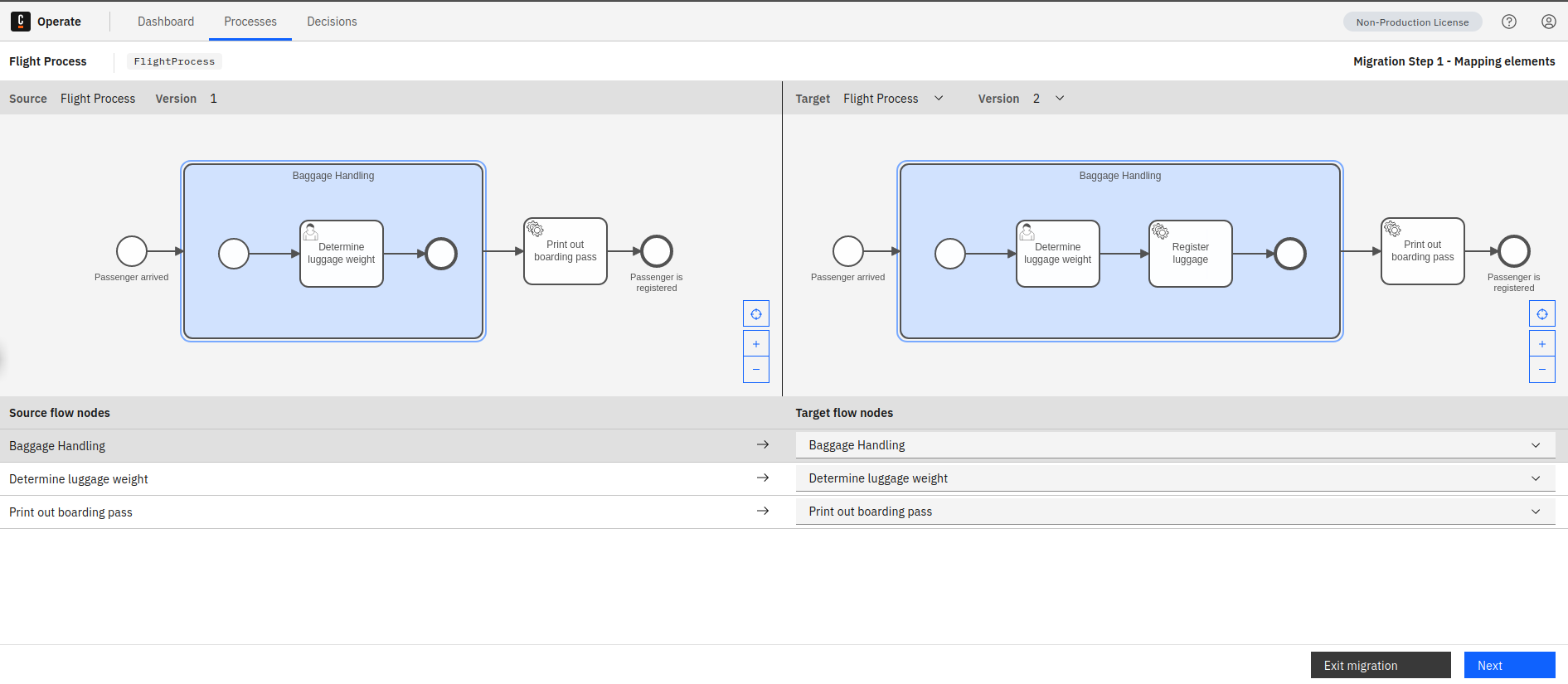
We hope you enjoy everything in the latest Operate 8.5 release!
Zeebe
Zeebe REST API
The first step to offer an intuitive and consistent experience via a single, unified Camunda 8 REST API is to provide a Zeebe REST API. With this release, developers can use the Zeebe REST API to manage Zeebe User Tasks, enabling immediate task state changes. The Zeebe REST API includes support for identity authentication and multi-tenancy, ensuring parity to the Zeebe gRPC API.
Compensation Events
Compensation events and activities are very powerful constructs for handling situations where you have a process that may need to be canceled under certain circumstances.
BPMN compensation events and handlers allow you to undo or reverse the effects of activities in case of errors, exceptions, or cancellations, ensuring consistency, reliability, and compliance in complex business scenarios. Compensation supports the Saga pattern, and Zeebe, as Saga Coordinator, helps solve transactions without two-phase-commit in distributed systems.
Zeebe user tasks
Zeebe becomes the only component responsible for managing the state of the User Task with the introduction of the new User Task type – Zeebe User Task. With simplified application architecture, developers benefit from a more consistent experience finding all state modification APIs in Zeebe. This centralized approach streamlines development efforts, making it easier to implement unit tests and assert user task states effectively.
Spring client SDK
Camunda recommends using the officially supported Spring Zeebe Software Development Kit (SDK) for your Spring and Spring Boot projects to interact with the Camunda 8 engine API to build process applications. The Spring Zeebe SDK works with Zeebe gRPC and the new Zeebe REST API.
As always, this release incorporates bug fixes and additional minor improvements. Check out the full release notes for this month’s Zeebe 8.5.0 release right here.
Optimize
Reports on user task assignment
With this release, it is now possible to aggregate the duration of Zeebe User Tasks in the states “Assigned” and “Unassigned” for a “User Task” / “Assignee”. The evaluation per “Assignee” is only possible for Camunda SM and can be switched off via a configuration.
Have a look at the new options in the User Task Report now.
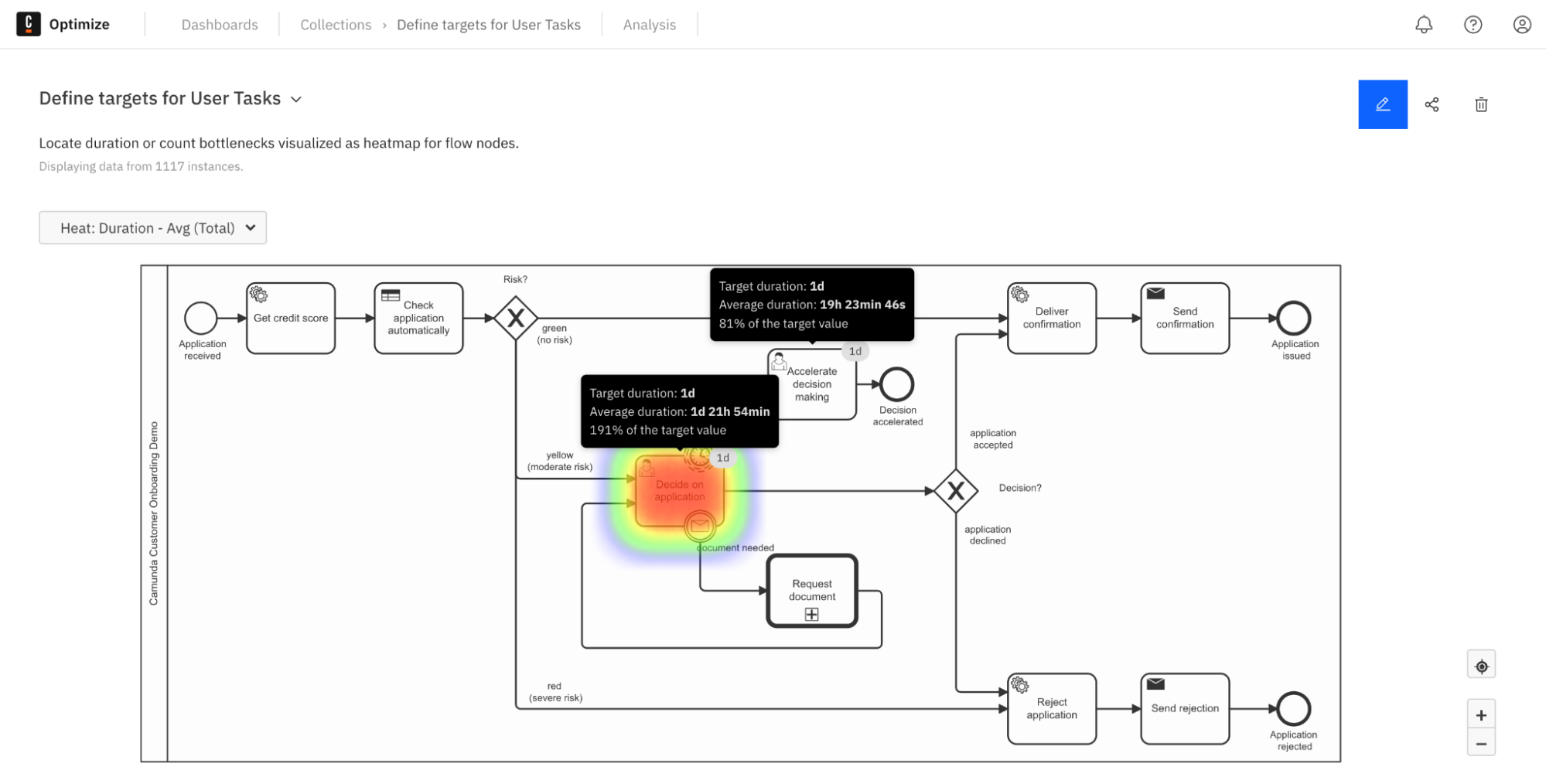
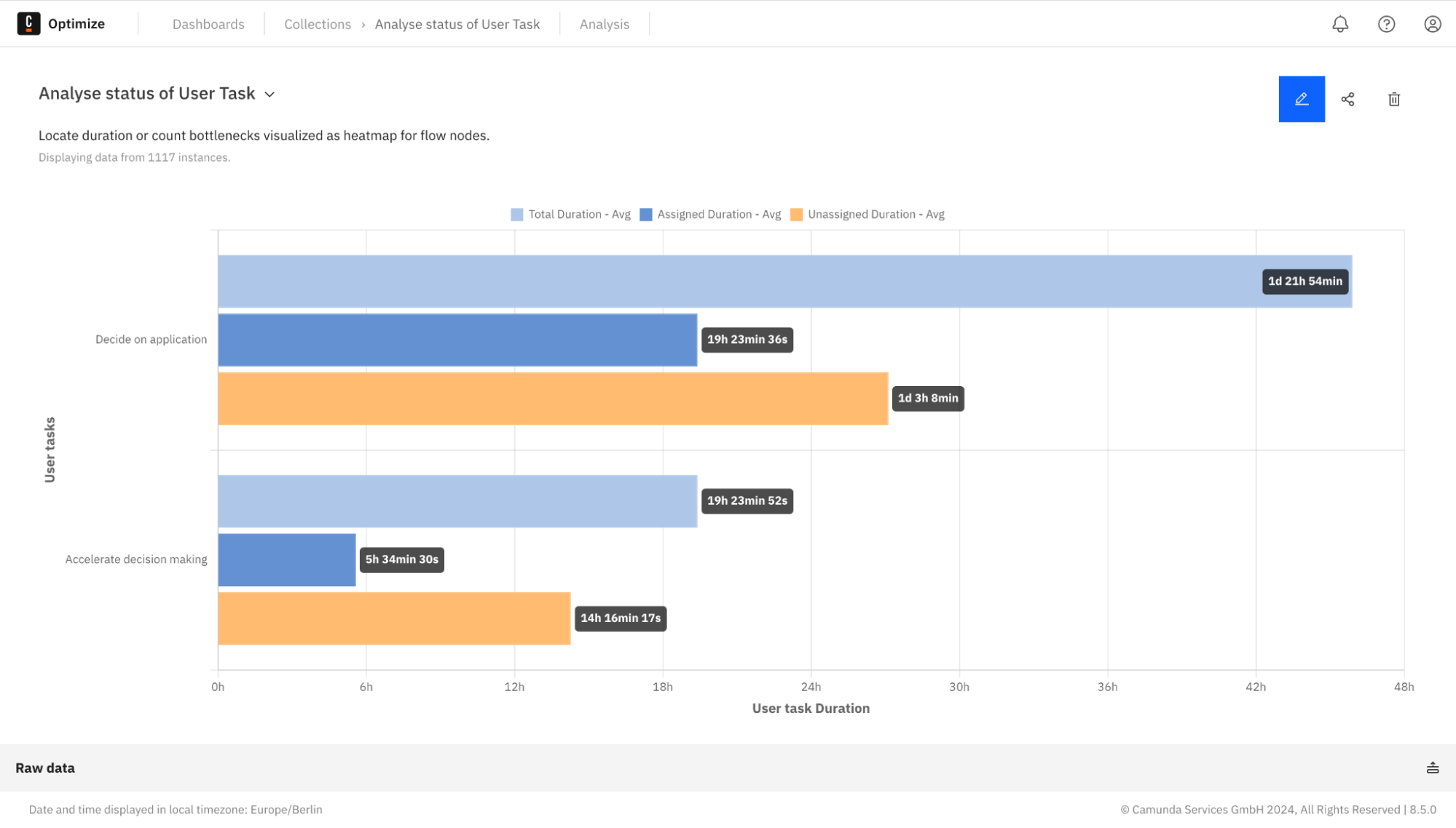
Process KPI Wizard
We are happy to provide the new Key Performance Indicator (KPI) wizard which provides a new way to build a KPI Report quickly and easily. The wizard is prepopulated with predefined KPIs that can be selected. It guides the users through the needed customizations and then generates an Optimize report.
The list of predefined KPIs will be extended with upcoming releases. Check it out and start setting up your first Process KPI today.
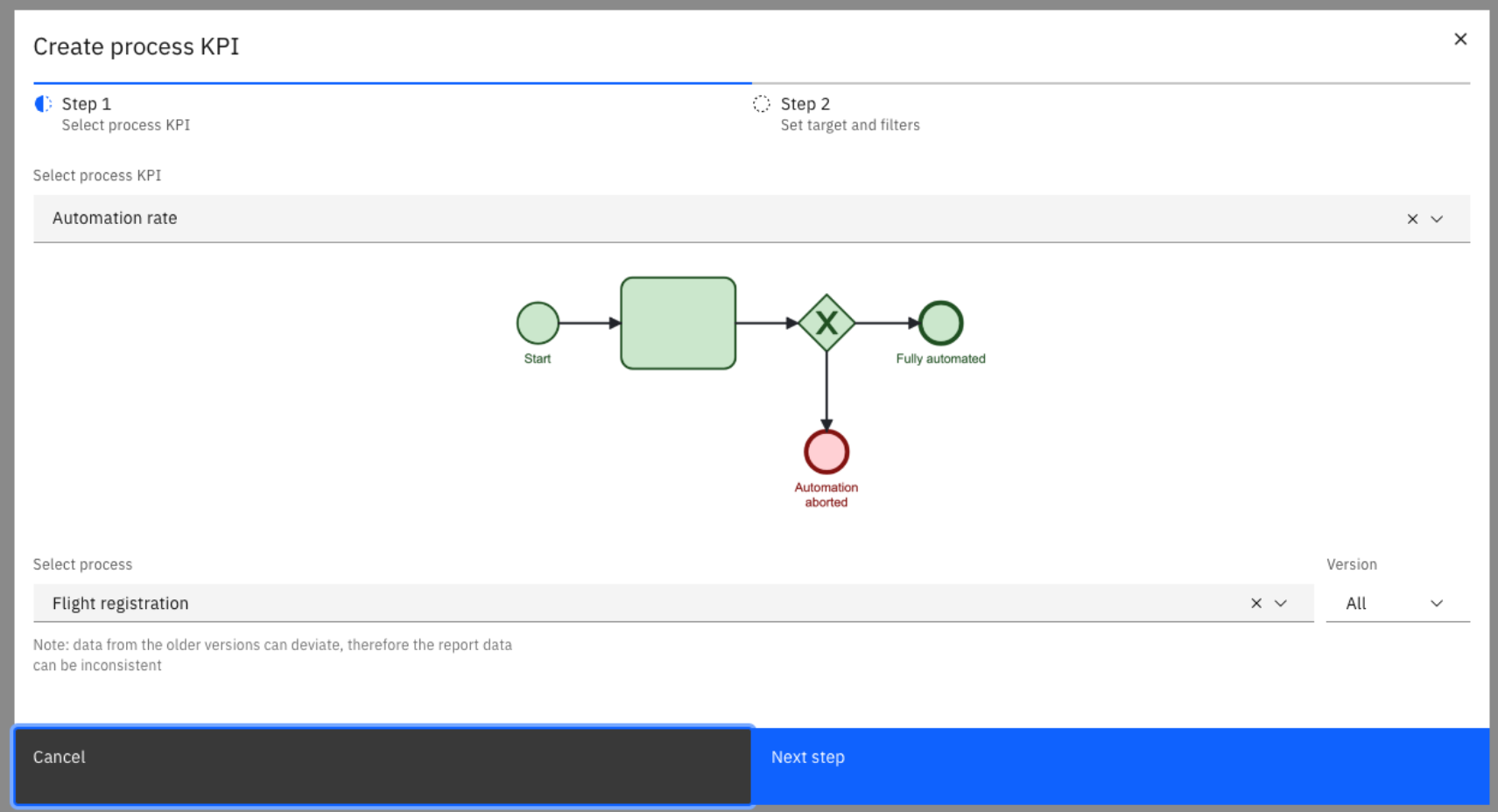
Custom adoption dashboards
We have extended Optimize so it is now possible to build reports evaluating up to 1024 data sources. This feature allows flexible evaluations across all processes to measure the adoption of specific patterns and process orchestration overall.
Accelerate building Reports and Dashboards
We constantly improve the experience of building reports and dashboards to make it easier and faster. With this release, we improved the following.
Copy reports on the dashboard
This new feature copies the selected dashboard including all configurations and allows it to be positioned freely on the dashboard. This lets you quickly compare different data sets using the same report configuration.
Copying is not only possible for reports, but also for all other tiles on the dashboard.

Display raw data in the report builder
You may want to build a report in Optimize with filters, but it can be challenging to understand which data is considered for a specific report with these filters applied. You can now display the raw data in the report builder to better understand the impact of filters defined for a specific report.
Start to build a report quicker by looking up the data the report is based on now and see how this feature provides insight into the data input.
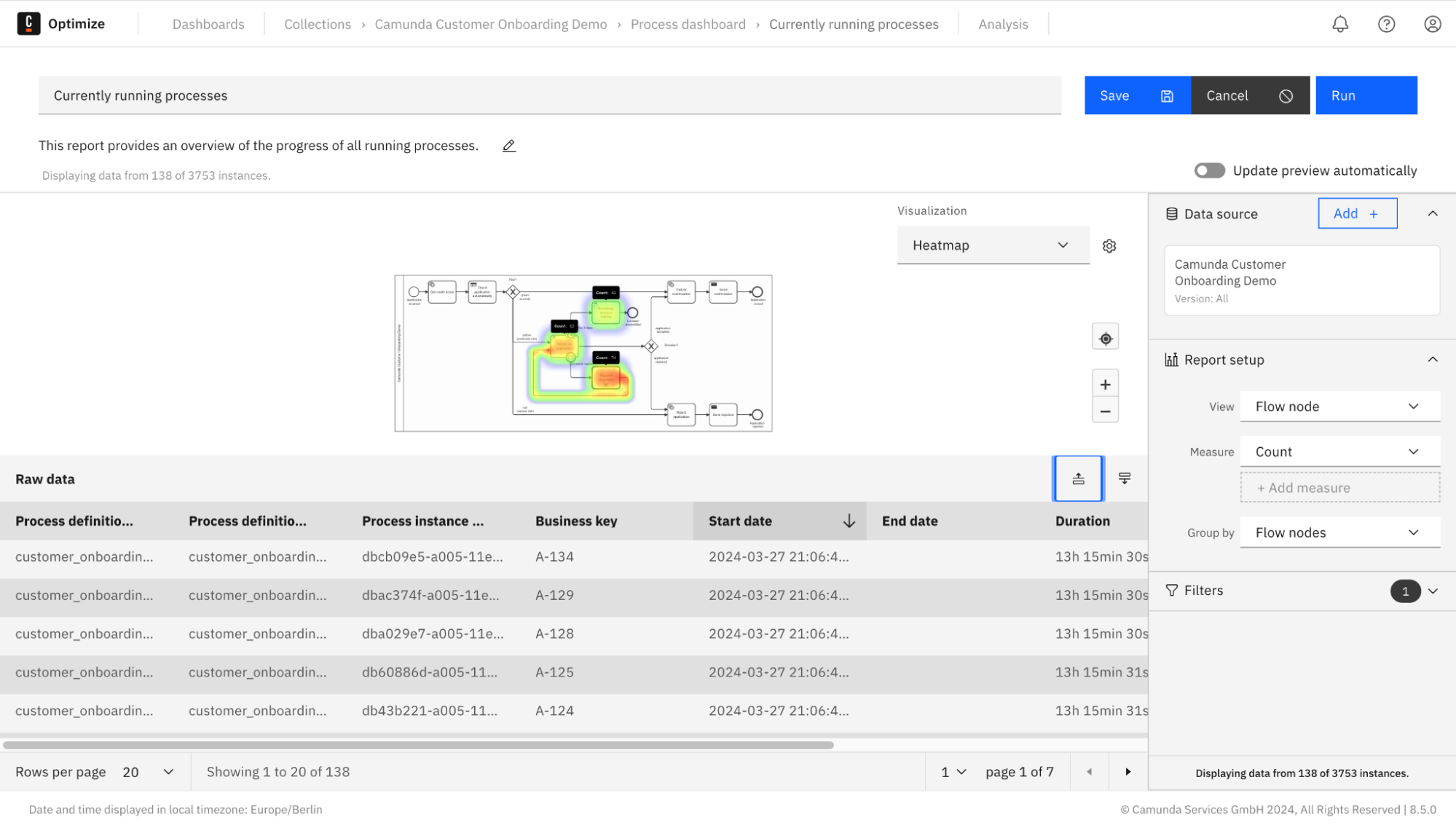
We hope you enjoy everything in the latest Optimize 8.5 release!
Tasklist User Interface (UI)
This release focuses on enhancing the productivity of task agents via a streamlined user experience, fine-grained access control, powerful filters, and a range of visual enhancements that allow users to stay focused and achieve goals in human-centered business processes.
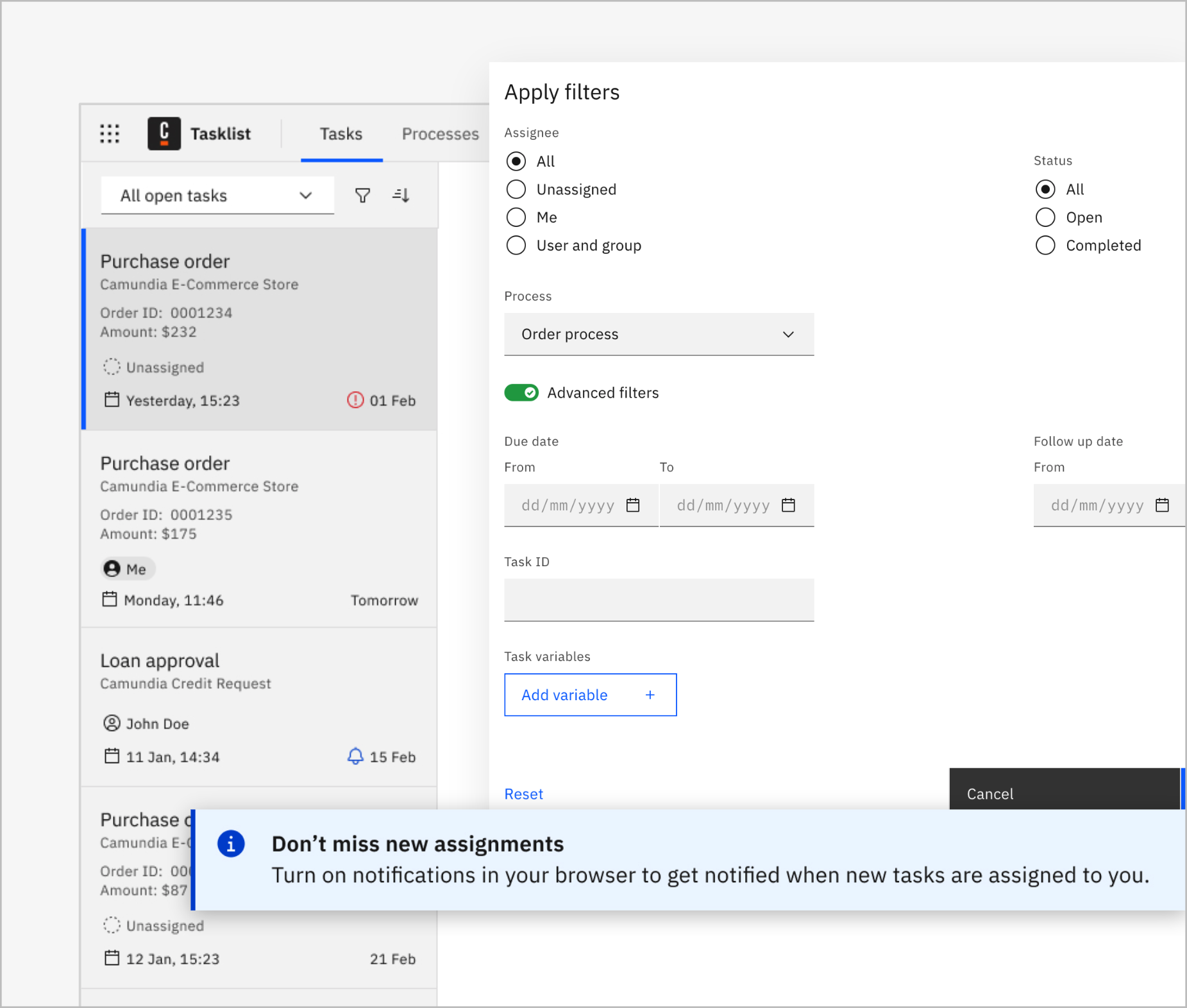
User task access control for SaaS
With this release, administrators can now define specific user groups that are authorized to perform certain tasks within Tasklist. This means that individual users and entire groups with a shared role or responsibility can be granted or restricted access to specific tasks.
This feature was already available in Camunda 8 Self-Managed and is now also offered in the SaaS distribution. Admins find a toggle to control this behavior in the cluster settings in Console.
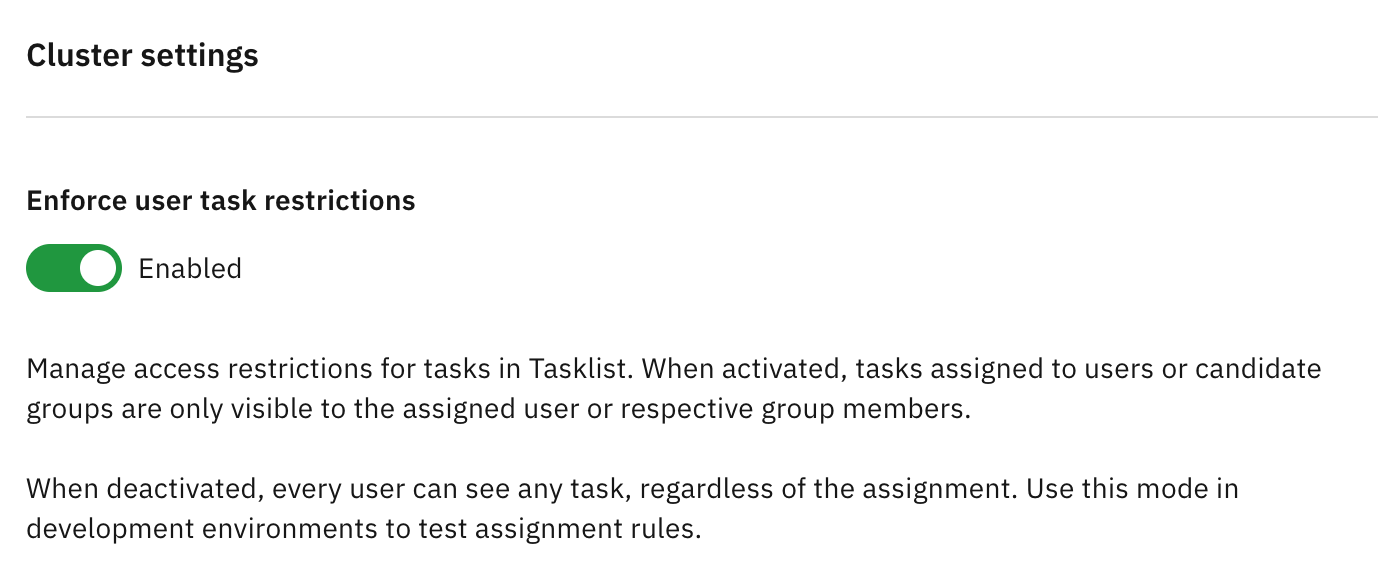
Task context description
Process developers can now expose variables and custom content on the task tile. This is provided using a reserved input variable called taskContextDisplayName. This will help users identify tasks in larger lists significantly faster based on their context.
The context description is also returned in task queries on the API, allowing it to use them in custom implementations.
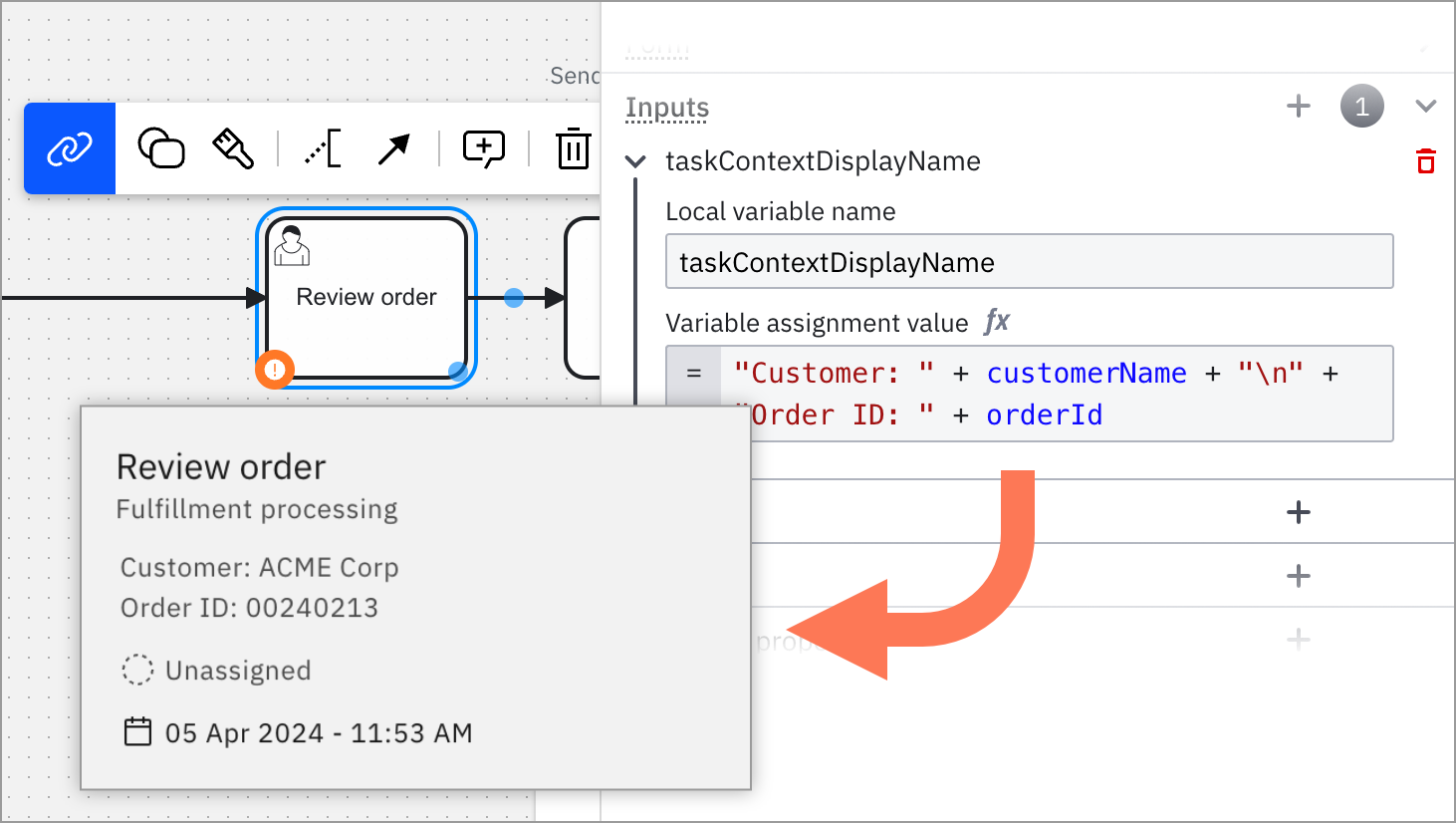
Custom task filters
Tasklist users can now create a custom filter to refine task search results by different attributes, such as the assignee, groups, processes, status, dates, and variables. Task agents can now easily find the tasks that should be worked on first, or find current and historical tasks for a particular business variable, e.g. to answer the status of a particular inquiry.
The filter is stored in the user’s browser and preserved across sessions.
You can see how to apply these filters in the figure below.
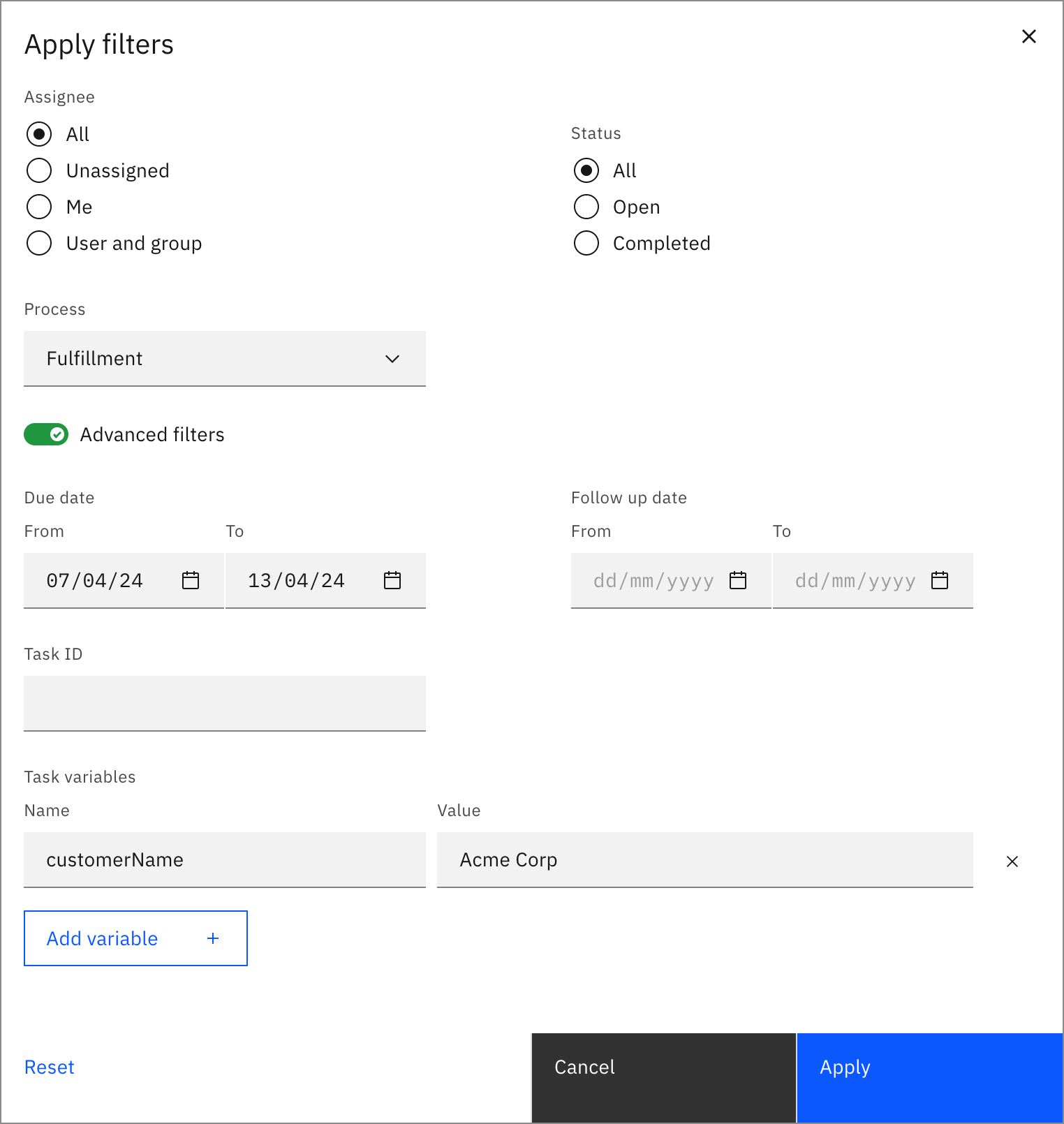
Task notifications
Now you can get notifications, in the form of browser alerts, when new tasks are assigned to you. You just need to ensure you enable notifications on Tasklist and grant permission in your browser settings.
Never miss an important task again and keep your workflow smooth and uninterrupted.
Auto-pick the next task
Users can now streamline their task workflows with the auto-pick feature. Perfect for those immersed in business process workflows involving multiple sequential tasks, such as claims processing, application processing, order processing, and more.
With this feature activated, as soon as you complete a task, Tasklist automatically queues up the next task for you, saving you time to decide and select the next task.
Invalid message when submitting forms
Users now receive an “invalid” message if required fields are empty or the field input is invalid when submitting a form. The message appears next to the submit button—ensuring the user sees the missed information—and summarizes the fields that the user missed.
Share processes with start forms via a deep link with authorization
Users can now share processes that start with a form with users inside their organization via Tasklist. The shared processes require Tasklist authorization to be started, in contrast to public forms. See the starting processes documentation.
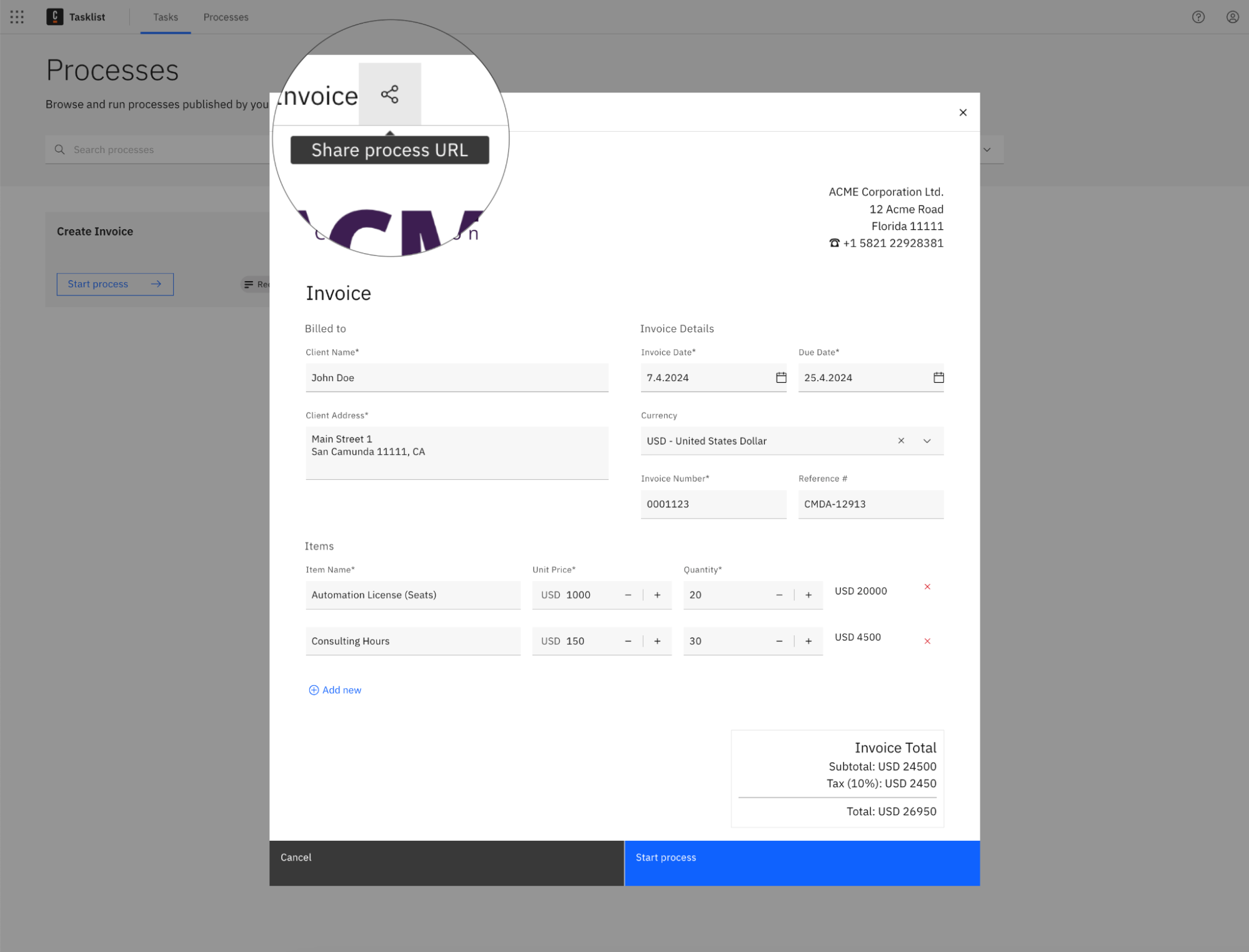
UI experience improvements
We made a couple improvements around the user interface experience to make it easier to identify relevant tasks and processes—ultimately increasing the productivity of teams working with Tasklist.
Task indicators
The task cards have been revamped and now provide easy-to-grasp indicators for the assignee by showing due, follow-up, and completion dates. Overdue tasks are highlighted to ensure users complete them as soon as possible. Together with the context description that appears now on the task tile, users can now identify relevant and urgent tasks faster.
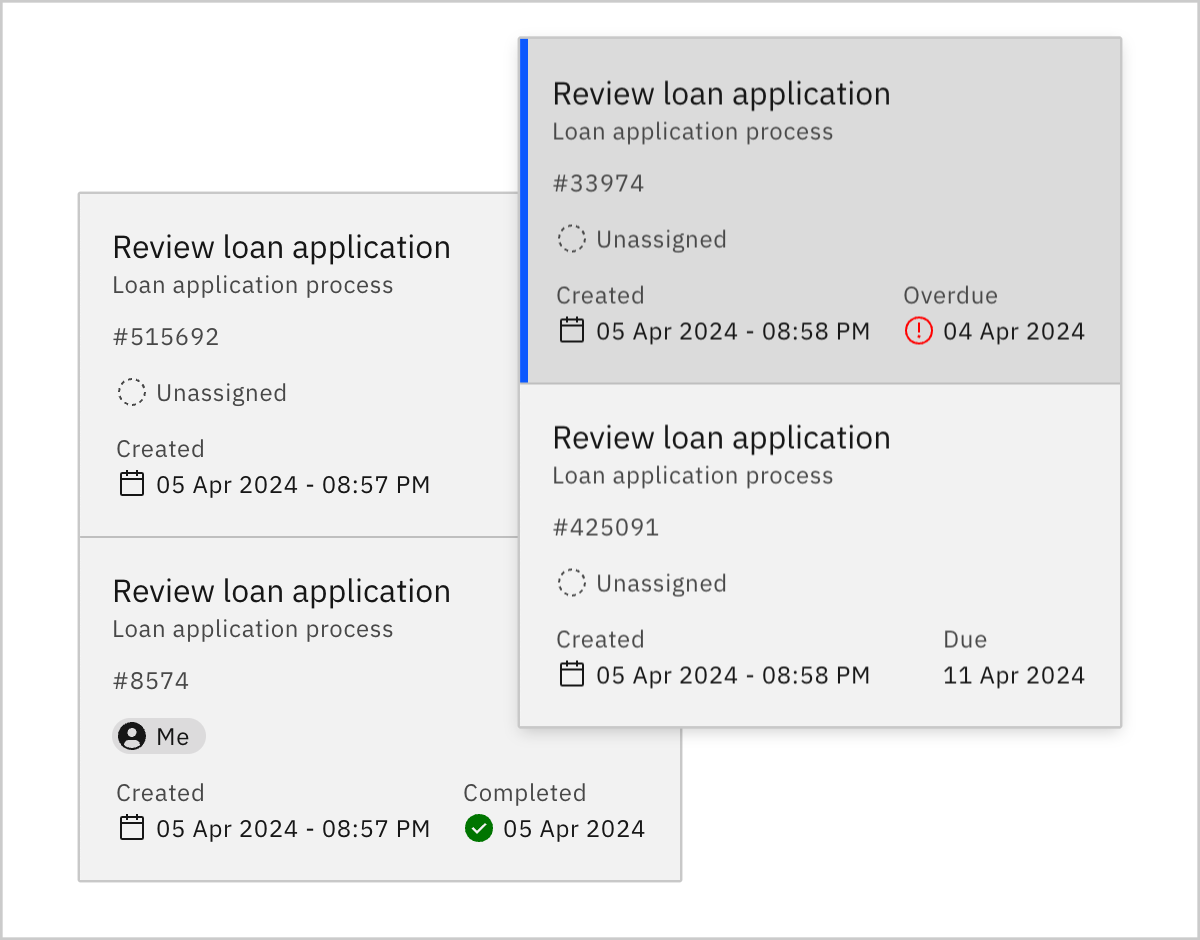
A new UI for the processes page
With this release, we introduce a new user interface for the processes page. Users can now filter for processes that have a start form which will be indicated with a label. This helps to easily identify those processes that require user input.
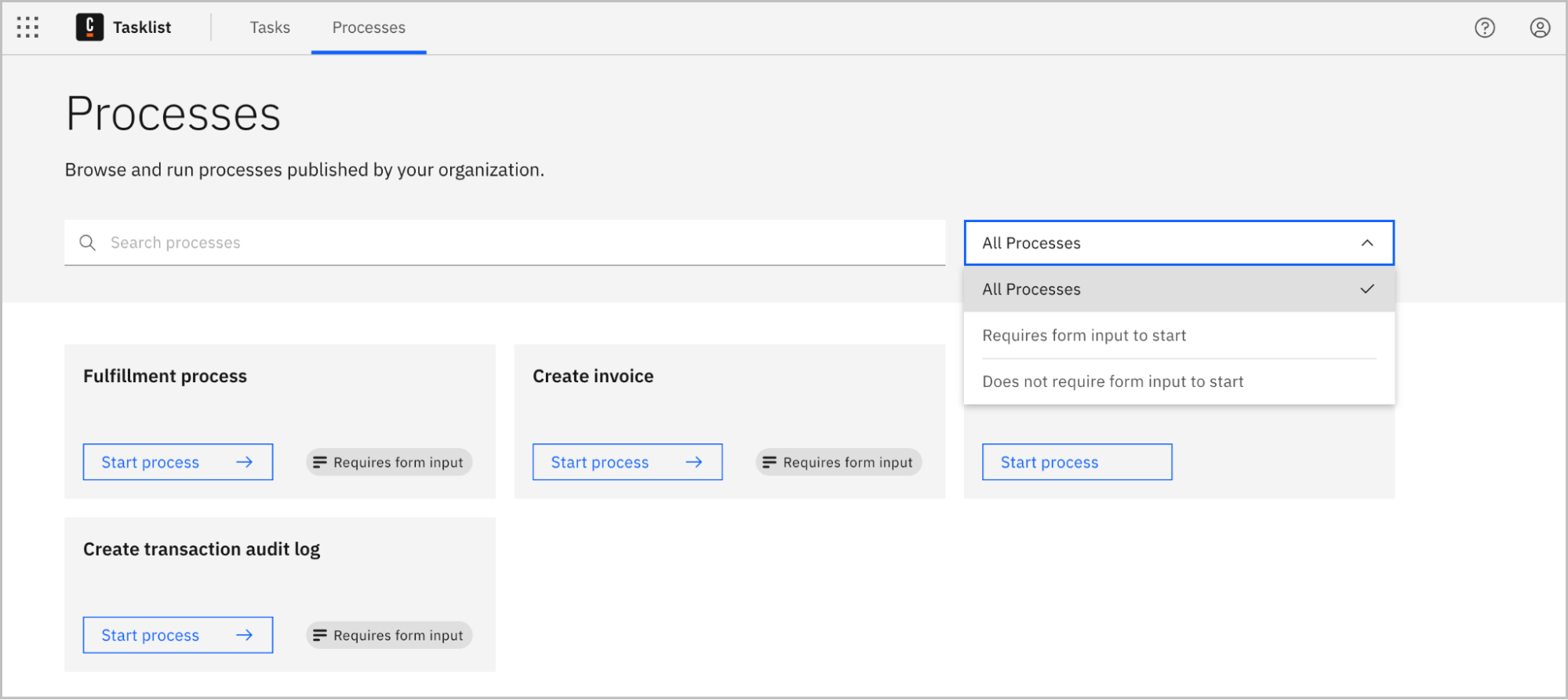
Tasklist API
New task type for user tasks
Developers can now create user tasks using the new type “Zeebe User Tasks”. These tasks will be created and processed by Zeebe and provide a faster and more reliable experience during the life cycle of tasks.
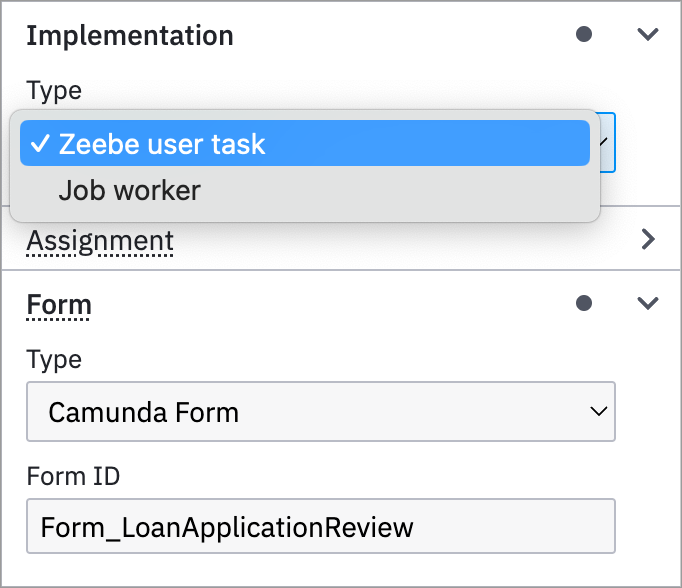
In addition, these tasks come with a new API that offers powerful new operations. Developers can update the due and follow-up date or candidate groups and users anytime during the lifetime of a task. It’s also possible to pass a custom action to assignments, updates, and completions, such as to track the origin of the action, the task outcome (e.g. “approved” or “rejected”), or when a task is started or paused.
Learn more about the new task type in the migration guide, and about the new task life cycle capabilities in the frontend developer documentation.
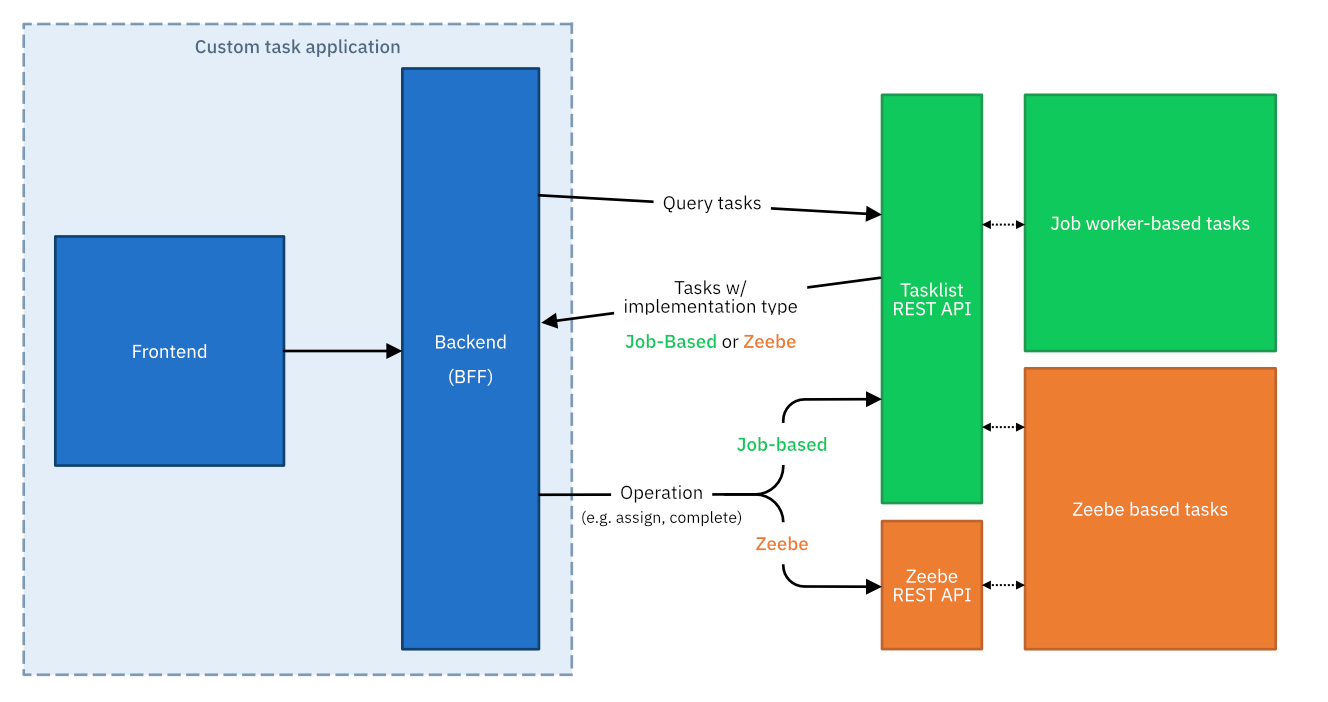
Search tasks by multiple candidate groups/assignees
It is now possible to search tasks by multiple candidate groups or users. This improves the efficiency of task queries, removing the need for multiple API calls and merging the results on the client. When users are members of multiple groups, use it to query all tasks that are relevant to them.
Forms
HTML viewer component
To enhance the flexibility of forms, you can now write any HTML—including separate, isolated styles—to extend your form your way. Combine your HTML with templating and expressions to render dynamic content based on your form and process variables. Focus on your content and style and relax while comprehensive sanitization protects your forms from common threats such as XSS and clickjacking attacks while allowing for maximum creativity.
Learn more in the docs, or find examples in the example repository.
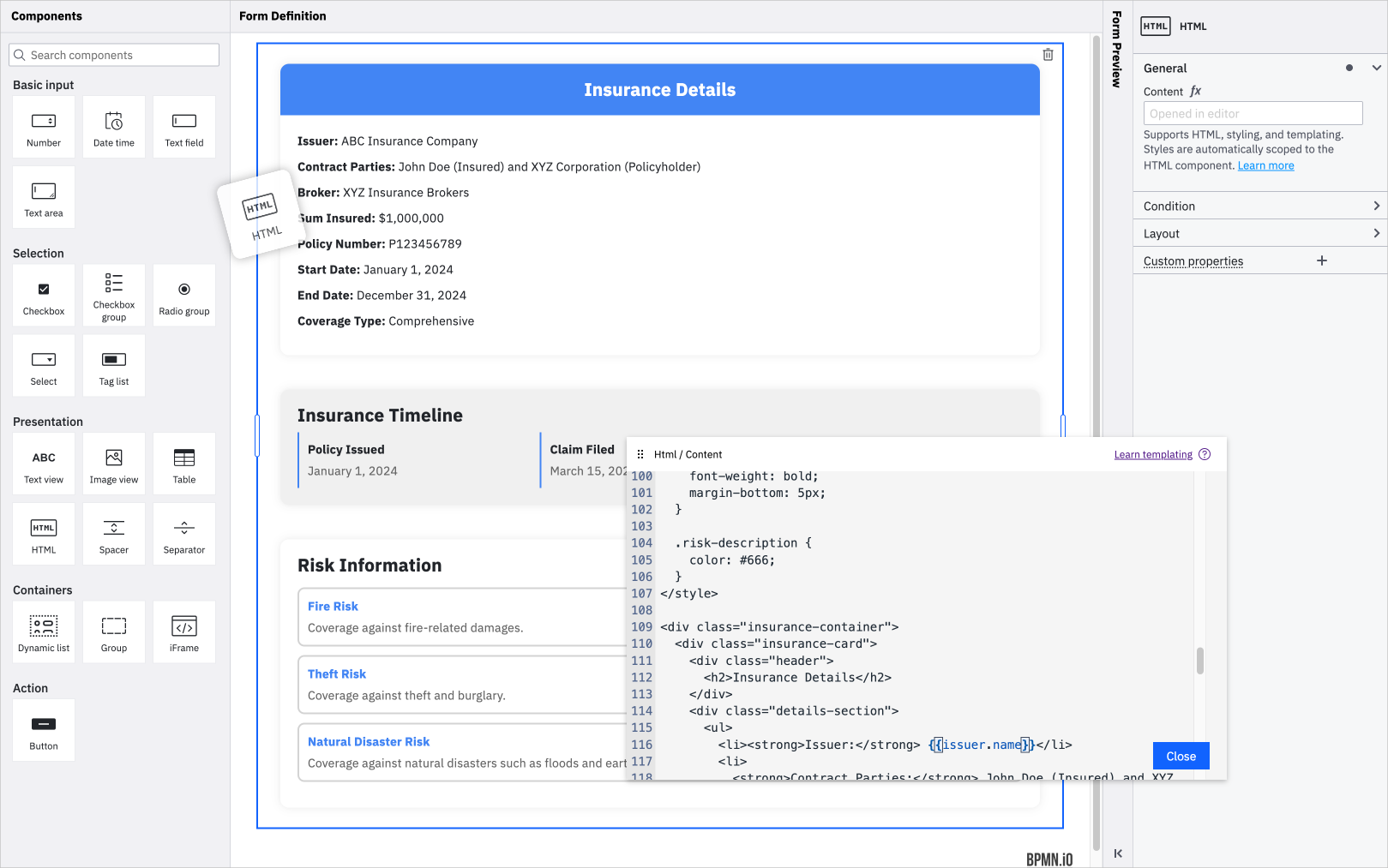
iFrame component security flags
We extended the iFrame component with security flags, so you can embed any supported external content while keeping control of every aspect of the security of the integration. Only allow those flags that are relevant for your form, and nothing more.
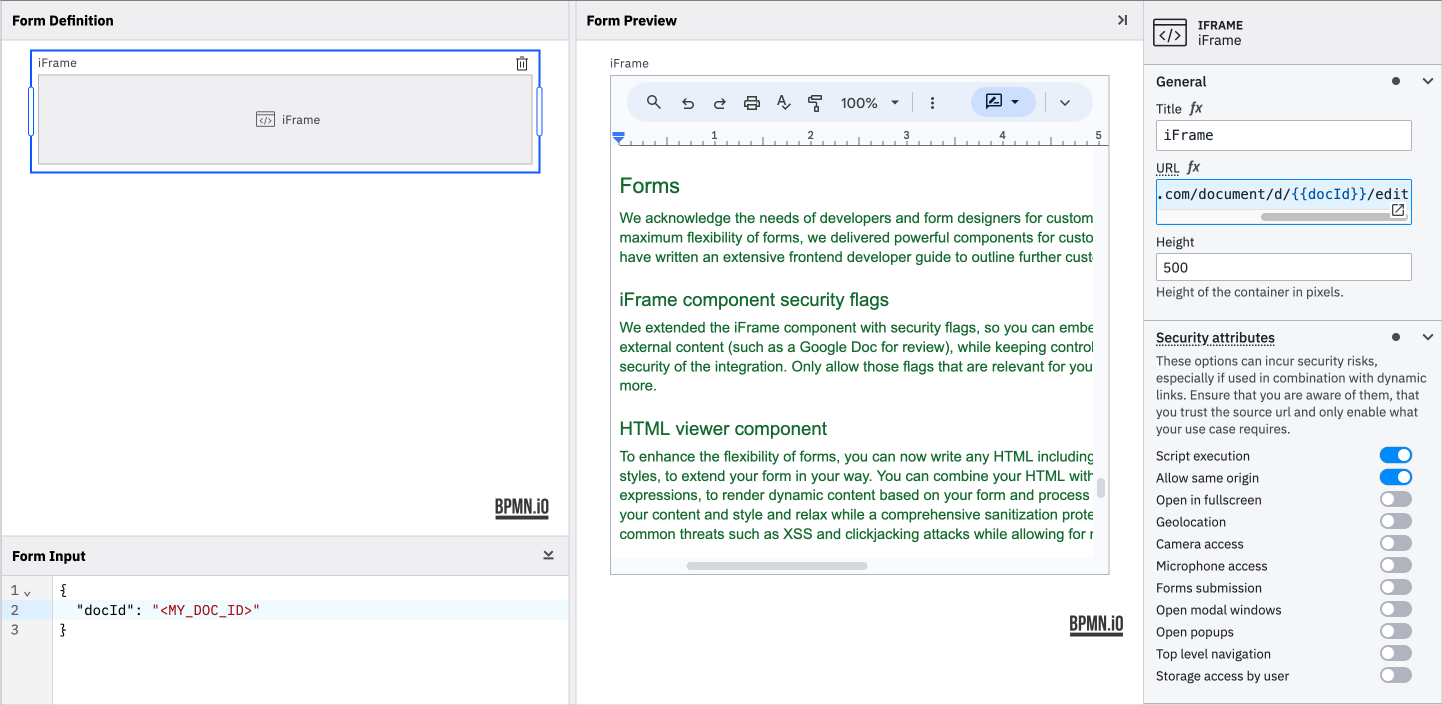
Learn more about the iFrame component in the docs.
Expression component
Use the new expression component to calculate and store values and reuse them in other components, allowing to break down complex expressions in multiple steps, and to return calculated values as form output.
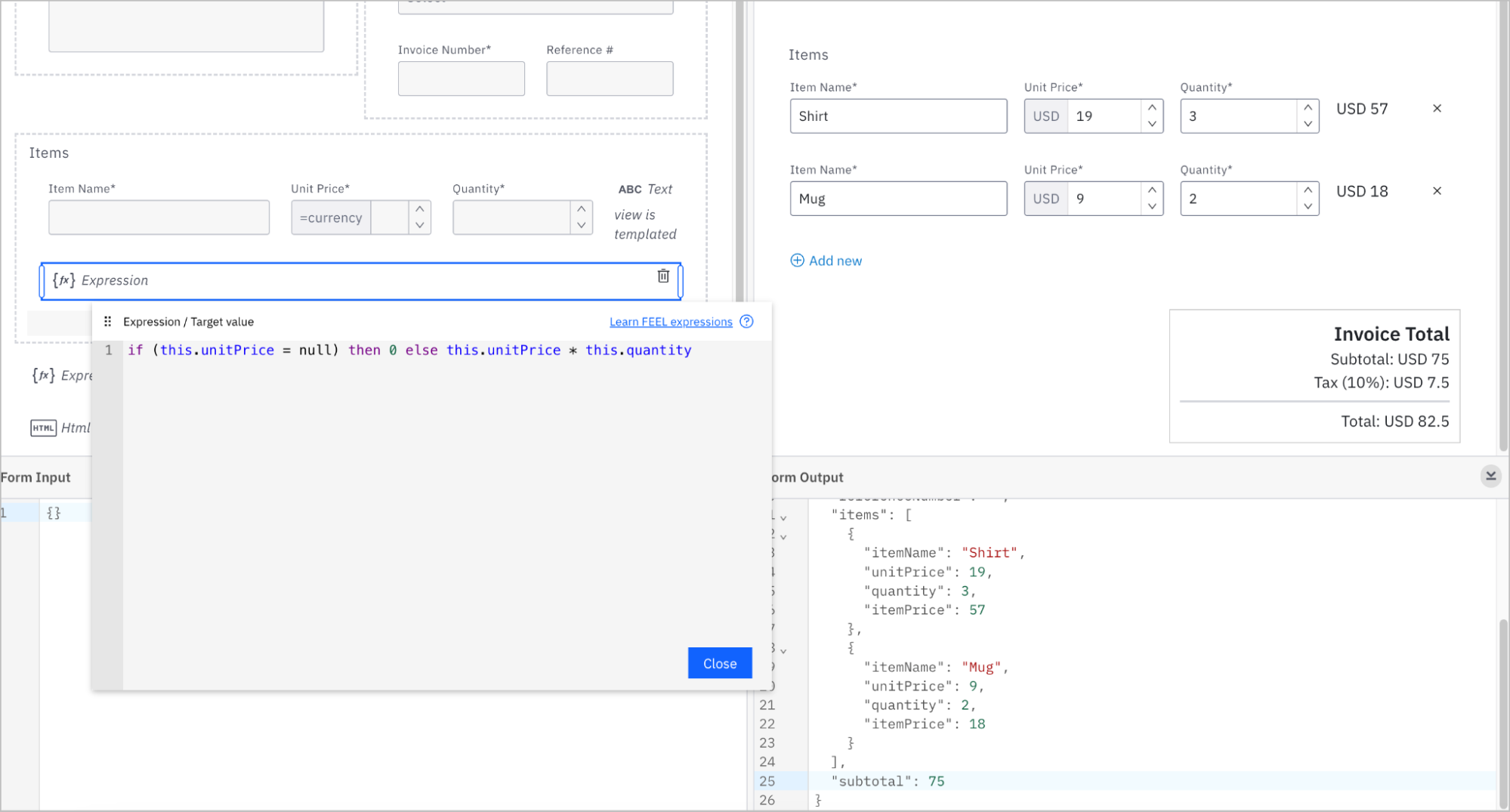
Frontend developer documentation
Are you a front-end developer? We’ve got you covered. We introduced a documentation chapter for frontend developers on how to create a custom task application and how to embed and customize form-js, the open source forms library that can be used to render Camunda forms in any application. If you are curious about this chapter, take a jump to the documentation to check it out.
Camunda 7
Our latest release of Camunda 7 focuses on iterative feature improvements to the Developer and Operator experience. We also upgraded supported environments to the latest version to ensure the long-term maintainability of Camunda 7, and allow for continued support until 2027 and extended support agreements until 2030.
Improved developer experience
With the latest Camunda 7 release, we have made several improvements around the developer experience.
- HTTP Client 5 and Configurable Apache HTTP client in the Java External Task Client
A new builder method has been introduced in the Java External Task Client, that gives access to the internal Apache HTTP Client, thus letting developers even further customize the client.
This method is the customizeHttpClient and it accepts a Java Consumer that is called with the internal Apache HttpClientBuilder parameter. This example shows how you can use this method to set custom response timeouts for instance:
ExternalTaskClient client = ExternalTaskClient.create()
.baseUrl("http://localhost:8080/engine-rest")
.customizeHttpClient(httpClientBuilder -> {
httpClientBuilder.setDefaultRequestConfig(RequestConfig.custom()
.setResponseTimeout(Timeout.ofSeconds(15))
.build());
}).build();- External Tasks can be prioritized by their Creation Date
TheFetchAndLockAPI has been enriched with the capacity to sort external tasks according to their creation date. The new capability is supported via all standard integrations such as the Java API, REST API, Java Client, or the respective JS Client.
Multi-level sorting can be performed by combining priority and createTime as sorting criteria. On External Tasks priority equality, the user will be able to specify the fetching order (ascending or descending) that results should be returned from theFetchAndLockAPI. - Add SkipIoMapping Support to BatchDeletion Operation
- Set local variables in the triggered execution by message correlation
- Docker start: extended WAIT_FOR
- Log synchronous message correlations to operations log
- Preserve externally set MDC logging properties
- Inform how to set HTTL for all process instances
- Exclusive jobs across sub-process instances
Improved operator experience
- Improved execution metrics overview
The improved execution metrics overview allows the user to monitor his execution metrics and trends over time easily. It also provides an option to easily copy the annual metrics to the clipboard and share it with Camunda as part of the yearly renewal. The new feature not only copies the execution metrics to the clipboard but also parts of the telemetry information. This information helps us at Camunda to better plan supported environments. If you do not want to share this information—just remove it before sending the execution metrics to Camunda.
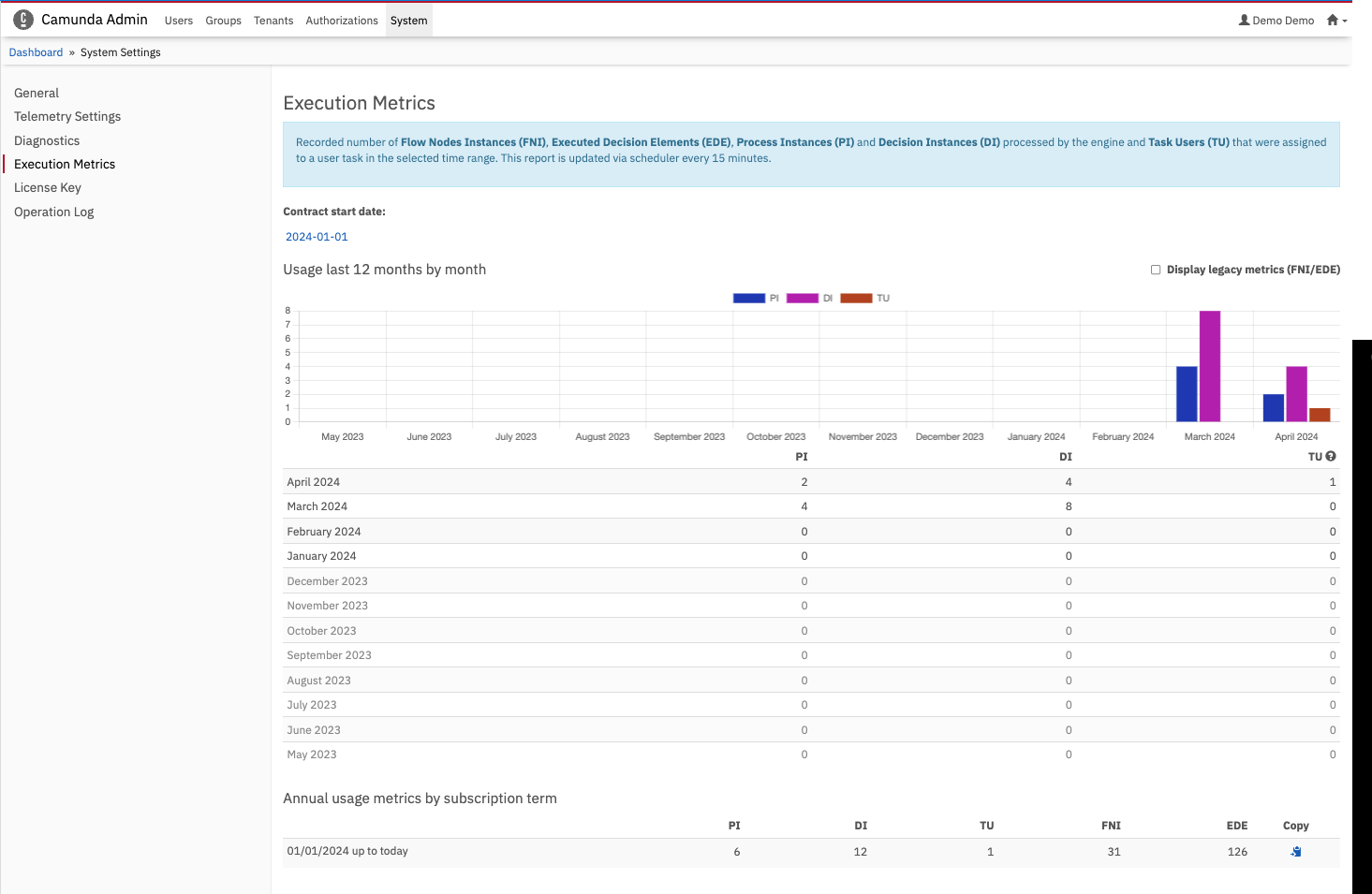
- Display BPMN process documentation field in Cockpit
- Heatmap statistics 5-minute and 1-hour filters
- Improved process definition search in Cockpit
Long-term maintainability (highlights)
Camunda continues to ensure long-term maintainability. Some highlights of that work can be found below:
- Support for Spring Boot 3.2
- Support for Java 21 LTS
- Support for WildFly Application Server 31
- Support for Quarkus 3.8 LTS
- Support for Amazon Aurora PostgreSQL 15
- See all changes
You can find the latest release notes for Camunda Platform 7.21 on our forums. Check them out right here.
Thank you
We hope you enjoy our latest minor release updates! For more details, be sure to review the latest release notes as well. If you have any feedback or thoughts, please feel free to contact us or let us know on our forum.
If you don’t have an account, you can try out the latest version today with a free trial.
Join us live to learn more!
You can learn more about recently released features in our upcoming webinar scheduled for May 22, 2024, 14-15:00 UTC. Sign up today to save your seat!
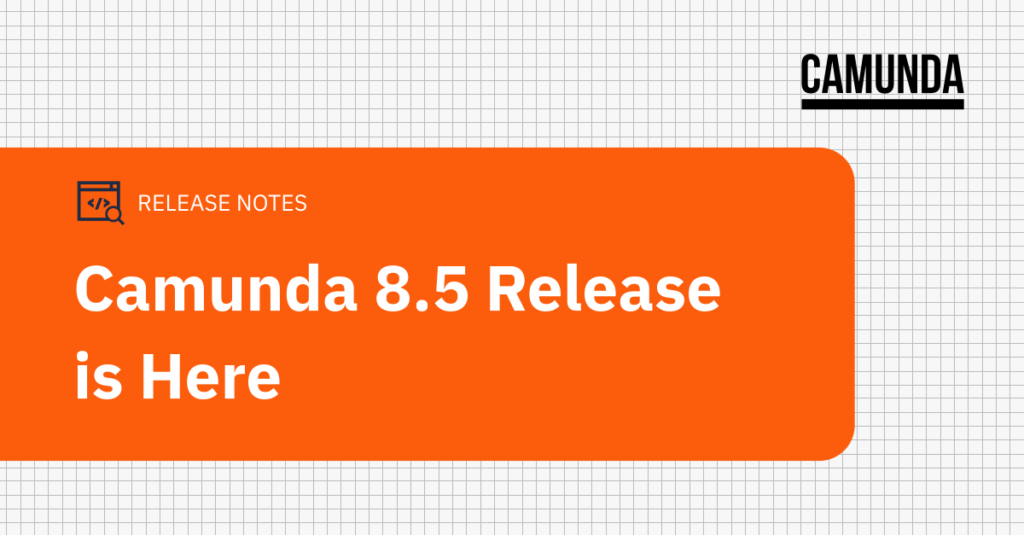

Start the discussion at forum.camunda.io